Fall P iz z a
Duck Gets a Makeover
Saveur Restaurant

A Meal of Corn
Northern Quarter
Top 5: Mussels
Eating in Mexico City
Portuguese Wines
Bone Broth Arrives







Smart. Local. Delicious.






































Duck Gets a Makeover
Saveur Restaurant

A Meal of Corn
Northern Quarter
Top 5: Mussels
Eating in Mexico City
Portuguese Wines
Bone Broth Arrives







Smart. Local. Delicious.


















































There are so many ways to celebrate the return of fall. From large family dinners at Thanksgiving to smaller, more intimate get togethers like ones celebrating the last warm evenings on the deck. This transition from summer to winter on Vancouver Island is one of my favourite seasons of the year. I remember visiting a local cidery a couple of years back and enjoying a cup of spiced, hot apple cider while watching the apples being ground and pressed to make the “must” for fermentation. The smell of the apples and spices somehow seem heightened against the coolness of day. I love to see heavier red wines back on the dinner table, too; and I go from easy evenings grilling outside to moving back into the kitchen to cook soups, braise meats, and doing some serious baking. Dive into our September/October issue and you’ll find many things local to get excited about. In our recipe feature we showcase all things squash with Fall Squash Pizza with fresh sage and a touch of nutmeg and Squash Cake with cinnamon and toffee sauce (pg. 28). Trust me, both are amazing. We also take a look at duck (pg. 32) and find it is turning up on all sorts of menus from diners to innovative small restaurants. If you’ve been thinking duck is only for special occasions, think again. Now that fall this issue has been put to bed, it’s time for me to open a big red wine, fire up the wood stove, and settle down to a great meal with some close friends. Good eating everyone and happy autumn.
HAND-CRAFTED BREAD MADE WITH FRESHLY STONE-MILLED FLOUR AND ONLY CERTIFIED ORGANIC OR SUSTAINABLY GROWN LOCAL INGREDIENTS . NATURALLY LEAVENED AND BAKED TO CRUSTY PERFECTION IN WOOD-FIRED BRICK OVENS.


FOUNDER & EDITOR Gary Hynes
PUBLISHER Pacific Island Gourmet
SPECIAL PROJECTS EDITOR Colin Hynes
CONTRIBUTING EDITOR Carolyn Bateman
VANCOUVER CONTRIBUTING EDITOR Julie Pegg
DRINK EDITOR Treve Ring
SENIOR WINE WRITER Larry Arnold
ART DIRECTION Gary Hynes
COPYEDITOR Cynthia Annett
Tofino | Ucluelet Jen Dart | Victoria Rebecca Baugniet | Cowichan Valley-Up Island
Kirsten Tyler
CONTRIBUTORS
Larry Arnold, Joseph Blake, Michelle Bouffard, Holly Brooke, Adam Cantor, Cinda Chavich, John Crawford, Jennifer Danter, Pam Durkin, Gillie Easdon, Jeremy Ferguson, Colin Hynes, Jon Johnson, Sol Kaufman, Tracey Kusiewicz, Sophie MacKenzie, Sherri Martin, Elizabeth Monk, Michaela Morris, Simon Nattrass, Elizabeth Nyland, Tim Pawsey, Julie Pegg, Treve Ring, Kaitlyn Rosenburg, Adrien Sala, Shelora Sheldan, Michael Tourigny, Sylvia Weinstock, Rebecca Wellman.
Cover photography by Michael Tourigny
Correction: In the last issue’s article on Oak Bay Butchers Rebecca Teskey, co-owner of the Village Butcher, was inadvertently left out. Rebecca Teskey and Michael Windle are co-owners of the business. We reget any inconvenience this may have caused.
Since 1998 | EAT Magazine is published six times each year. No part of this publication may be reproduced without the written consent of the publisher. Although every effort is taken to ensure accuracy, Pacific Island Gourmet Publishing cannot be held responsible for any errors or omissions that may occur. All opinions expressed in the articles are those of the writers and not necessarily those of the publisher. Pacific Island Gourmet reserves the right to refuse any advertisement. All rights reserved.
OUR
1. EAT has advertisers in our magazine and on our website; they are our primary source of income. Our company, Pacific Island Gourmet, employs a dedicated advertising team responsible for selling ad space in EAT and on EatMagazine.ca. The EAT editorial team does not accept money or other consideration from companies as a condition or incentive to write a review or story. All editorial content on EAT is based on the editor’s discretion, not on the desire of any company, advertiser or PR firm. Occasionally EAT and EatMagazine.ca may publish sponsor content, which will be labelled.
2. EAT contributors are not allowed to ask for free meals or drinks. Anyone identifying themselves as being on assignment for EAT will be able to prove their employment.
ADVERTISING DIRECTOR Gary
Hynes SENIOR ACCOUNT MANAGER Susan Worrall DIRECTOR OF BUSINESS DEVELOPMENT Lindsay Van Gyn VANCOUVER SALES Clevers Media

ADVERTISING 250.384.9042, editor@eatmagazine.ca
WEBSITE EatMagazine.ca
MAILING ADDRESS Box 5225, Victoria, BC, V8R 6N4 TEL 250.384.9042

EMAIL editor@eatmagazine.ca

PICK-UP THE MAGAZINE EAT is delivered to over 300 pick-up locations in BC including Victoria & Vancouver, Vancouver Island. Visit our website for locations
Publisher Pacific Island Gourmet |
® is a registered trademark.



The Royal BC Museum rolled out its first ever Food Truck Festival this summer. Running until Sept 26, the RBCM's back courtyard will be transformed into an international food fair, featuring some of the finest food trucks in Victoria. Participating food trucks include DeadBeetz, Pig BBQ Joint, A Streetcar Named New Orleans, Puerto Vallarta Amigos, The Love Perogy and Wild West BBQ Salmon. Stop by the Truffles Catering station for a local beer or wine. Daily 11:00 am-6:00 pm. (royalbcmuseum.bc.ca/foodtrucks)


Award-winning Executive Chef James Walt will craft exclusive four-course menus that showcase his internationally recognized farm-to-table dishes. With wine pairings by Samantha Rahn, 2013 Sommelier of the Year, and service orchestrated by renowned Restaurant Director Neil Henderson, the Longtable Dinners salute both Araxi's culinary provenance and its future. Sept 5. Tickets $159 plus taxes and gratuity. (araxi.com/longtable)
The Great Canadian Beer Festival has become one of the worlds' must-attend beer events. People from all over the globe seek out Victoria and the GCBF every year; the event attracts brewers from Australia, volunteers from England and beer lovers from all over. In support of C-Fax Santa's Anonymous, the GCBF will be held Sept 11 – 12. (www.gcbf.com)
On Sept 12, take the self-guided Urban Food-Garden Tour and visit your choice of 14 diverse and inspiring home food gardens — back yards, front yards, allotments, boulevards. Talk with home gardeners and expert-gardener volunteers about Year-round food production at home, Veggies, bees, chickens, fruit trees, mushrooms, Soils,

sustainable water use, community gardens, and more. Tickets $15 (under 15 free) at GardenWorks, brownpapertickets.com Haliburton Farm stand at Moss St Market, the Hudson Public Market, Oaklands Market or email vicfoodgardens@gmail.com


The UBC Farm will host the Lower Mainland Feast of Fields on Sept. 13, from 1pm- 5pm. The Vancouver Island Feast of Fields will be held Sept. 20, from 1-5 pm at O.U.R. Ecovillage, Shawnigan Lake. For ticket purchase information visit feastoffields.com

The fifth edition of this event is a showcase of international and local wines, craft and premium beer as well as local cheesemakers and chocolatiers. The consumer event runs from 7:00 pm to 10:00 pm and ticket registration is available online. The Cork & Keg Festival will host 600 attendees from the Fraser Valley area and showcasing 55 wine and beer purveyors sampling over 300 products. Sept. 18 (corkandkeg.ca)
A fundraising dinner to support the Queen Mother Veronica Project to educate girls and end female genital mutilation. Dinner by Castro Boateng, music by Mbira Spirit. Silent Auction. St. Joseph the Worker Church, 753 Burnside Rd. W. Sept 26, $60. 250-474-2289 or joescaletta@hotmail.com

FEAST
One of the top food festivals in North America.. hell... the world. Feast Portland is four days of tasting, eating, sipping and learning from the top chefs, wineries, breweries and bartenders in Portland and around the USA in the coolest food city west of the Rockies. Sept 17-20. (feastportland.com)
VICTORIA WINE FESTIVAL (VICTORIA)





Over twenty wineries will be represented at the second annual Victoria Wine Festival, taking place at the Parkside Hotel and Spa on Sept 25-26. Events include a trade tasting and three public tasting sessions. The VWF will benefit the BC Hospitality Foundation. The BC Hospitality Foundation supports hospitality industry workers in times of financial crisis related to a medical condition and additionally has an extensive scholarship program. (vicwf.com) See article on page 24.

SAVOU R COWICHAN FESTIVAL (COWICHAN VALLEY)





A delicious, delectable and exciting event with over forty artisan food and drink










producers from the Cowichan Valley region, hosting more than fifty epicurean events over 10 days. Guests will have opportunities to explore and sample wines, ciders, spirits and beer of the region with barrel tastings, winery and cider tours and new releases. Participate behind the scenes; meet master winemakers, cider makers, brewmasters and the sommeliers that love them. The best of Cowichan will be on the menu at tasting events, cooking classes, winemakers’ dinners and demonstrations by top chefs in the area’s finest restaurants. Kicks off with “Barge on In”, a public tasting held on a barge moored at Mill Bay Marina. “Sip, Savour & Support” takes place on Oct 3 (also on the barge in Mill Bay) is a charity long table dinner with professional athletes, a ten-piece band, prizes and a star chef. Sept 25-Oct 4. (savourcowichan.com)
BREWERY AND THE BEAST - FESTIVAL OF MEAT (VICTORIA)
Chefs demonstrate their skill and passion for meat through a wide variety of delicious and inspired creations. Local and regional farms provide the highest quality meats to be featured in various cooking methods. Whole pig roasts, house-made sausage, charcuterie, smoked meats, ethnic-inspired dishes, classic BBQ, and other full-flavored exotic foods. (breweryandthebeast.com/Victoria)
BC WINE AWARDS RECEPTION & TASTING (FRASER VALLEY)
A phenomenal way to launch the Fall Okanagan Wine Festival. Be the first to see who wins at the annual British Columbia Wine Awards and have the rare opportunity to taste the best of British Columbia wines first hand. There are only 100 tickets available so book early. Speak to winemakers, savour local foods, and sip your way through a great evening. This is a Get Home Safe event, sponsored by BC Liquor Stores and Valley First Insurance. Oct 1 (thewinefestivals.com)
With Signature events happening at wineries and other venues across the Okanagan from Oct 1-11, this is a great way to get acquainted with the region USA Today just named the world’s second best wine region to visit. (thewinefestivals.com)

2015 APPLE FESTIVAL (SALT SPRING ISLAND)
The Salt Spring Island Apple Festival is an incredible little community event, attracting about 1500 apple lovers, celebrating the apples (and food) of Salt Spring Island and connecting you with the farms and farmers that produce this very special diversity of tasty, healthy food. Spring's apple history dates back to 1860. Oct 4, 9am – 5pm. (saltspringapplefestival.com)

The 4th annual edition of this festival shines the spotlight on the natural abundance of Salt Spring Island. On Oct 9-11, Sip & Savour Salt Spring unites growers, food producers, chefs and vintners from Salt Spring Island and the Vancouver Island region with local and BC vintners in the creation of some culinary magic. (sipandsavoursaltspring.com)
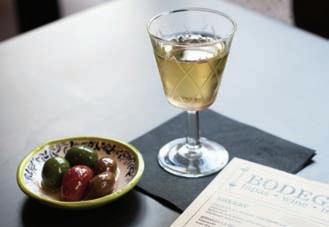

Art of the Cocktail, Victoria’s long-running cocktail festival, returns this October. It is a special two-day fundraiser for the Victoria Film Festival featuring all things cocktail. The Grand Tasting (Oct 24 ) is the cocktail event of the season – with samplings of the big and the boutique, from local distilleries to international brands, paired with a selection of locally-crafted hors d’oeuvres. There will be three, unique cocktail seminars held on Oct 25. Tickets and info at artofthecocktail.ca.
Oct. 16 from 4pm- 9pm at the Beban Park Auditorium. The Bite is TheatreOne's biggest annual fundraiser and Nanaimo's original gourmet food fair, featuring the city’s best local restaurants, pubs, bakeries and cafés. (theatreone.org).
This celebration of Canadian Excellence in food, wine, entertainment and athletics is held in 11 Canadian cities and has raised over $7.4 million to date for Canada's Olympic athletes. This year’s event will be held this year on Nov 19 at the Victoria Conference Centre. Tickets are available now. (goldmedalplates.com)
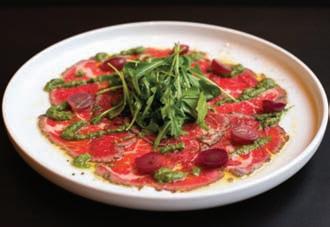















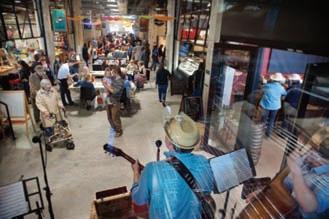
WHEN THE WEATHER TURNS CHILLY, THERE’S NOTHING MORE COMFORTING than a steaming bowl of soup. Current evidence suggests there may be nothing more salubrious either. Recent research has confirmed what Grandma knew all along: supping soup can enhance our health in several ways. Given soup’s usual “good-foryou” components—mineral-rich bones and nutrient-dense vegetables—this official confirmation of its restorative powers is hardly surprising. What is perhaps surprising is the intriguing ways soup optimizes well-being and how its status in the food world has gone from banal culinary staple to trendy “It” food.
One of soup’s most obvious health benefits stems from its very preparation. When we simply boil vegetables in water, up to 40 percent of their nutrient content is leached into the liquid we then unwisely discard. Soup preparation allows us to retain and ingest all those precious nutrients in the surrounding liquid, including disease-fighting antioxidants.

And, yes, research confirms that chicken soup can help alleviate the symptoms of the common cold. It isn’t just an old wives’ tale. According to recent studies, it does this by slowing the migration of certain white blood cells to the lung area and by inhibiting the pro-inflammatory conditions associated with viral infections and the common cold. What’s more, in addition to providing valuable hydration when we’re sick, soup bests other hot beverages when it comes to thinning pesky nasal mucus.
Staving off the sniffles isn’t the only reason to put soup on the menu, however. Several studies have shown that serving vegetable-rich soups as a first course is an effective strategy in helping to maintain a healthy weight. It seems eating veggie soup with meals helps enhance satiety and can reduce overall calorie intake at meals by as much as 20 percent. This effect was witnessed in both adults and children, with the added benefit of significantly increasing overall vegetable consumption in both groups.
Its efficacy as a “super-slimmer” is just one of the reasons a particular variety of soup—bone broth—is suddenly garnering media attention worldwide. How serious is the “buzz”? Celebrities like Dr. Oz and Gwyneth Paltrow have literally been gushing about the broth. They claim the collagen-rich liquid can help improve joint health and the appearance of skin, hair and nails; heal leaky-gut syndrome; reduce inflammation, and more. What exactly is bone broth you ask, and how is it different than regular old soup stock?
Bone broth is, well, exactly what is sounds like. It is a gel-like broth made from simmering copious amounts of animal bones in water, with a dash of an acid medium, like vinegar, added to leach out the bones’ valuable collagen and nutrients. Proponents of the broth claim what separates it from “garden-variety broth” (a.k.a. stock) is the amount of bones used, how long they are simmered and the addition of the acid medium. The long simmer is crucial apparently, as this breaks down the connective tissue of the bones and results in a stock with a higher protein and collagen content. Aficionados recommend a simmering time of 12-24 hours—stating the longer the simmer—the healthier the brew.
Whether or not the health benefits attributed specifically to bone broth are valid remains open for debate. To date the scientific studies proving soup’s health benefits have all been conducted using conventional soup recipes like Grandma made. However, you have to admit, the resemblance between this “elixir du jour” and the soup broths Granny made is pretty obvious. Regardless, the food world and the media have both decided to view bone broths as something different and “trendy.” In response, a new food venue—the bone broth bar—has hit the food scene, and the first of its kind in Canada is at Vancouver’s own On the Range Organics. Victoria has its own bone broth bar too at Nourish Kitchen & Cafe in James Bay.
So, is this a passing fad—is bone broth merely the new kale or quinoa? The question seems unworthy of consideration. It’s irrefutable: soup, made from scratch with wholefood ingredients—be it bone broth or minestrone—is a healthy, enduring, culinary classic, one that has provided sustenance and solace to humankind for millennia. Just ask Granny. E


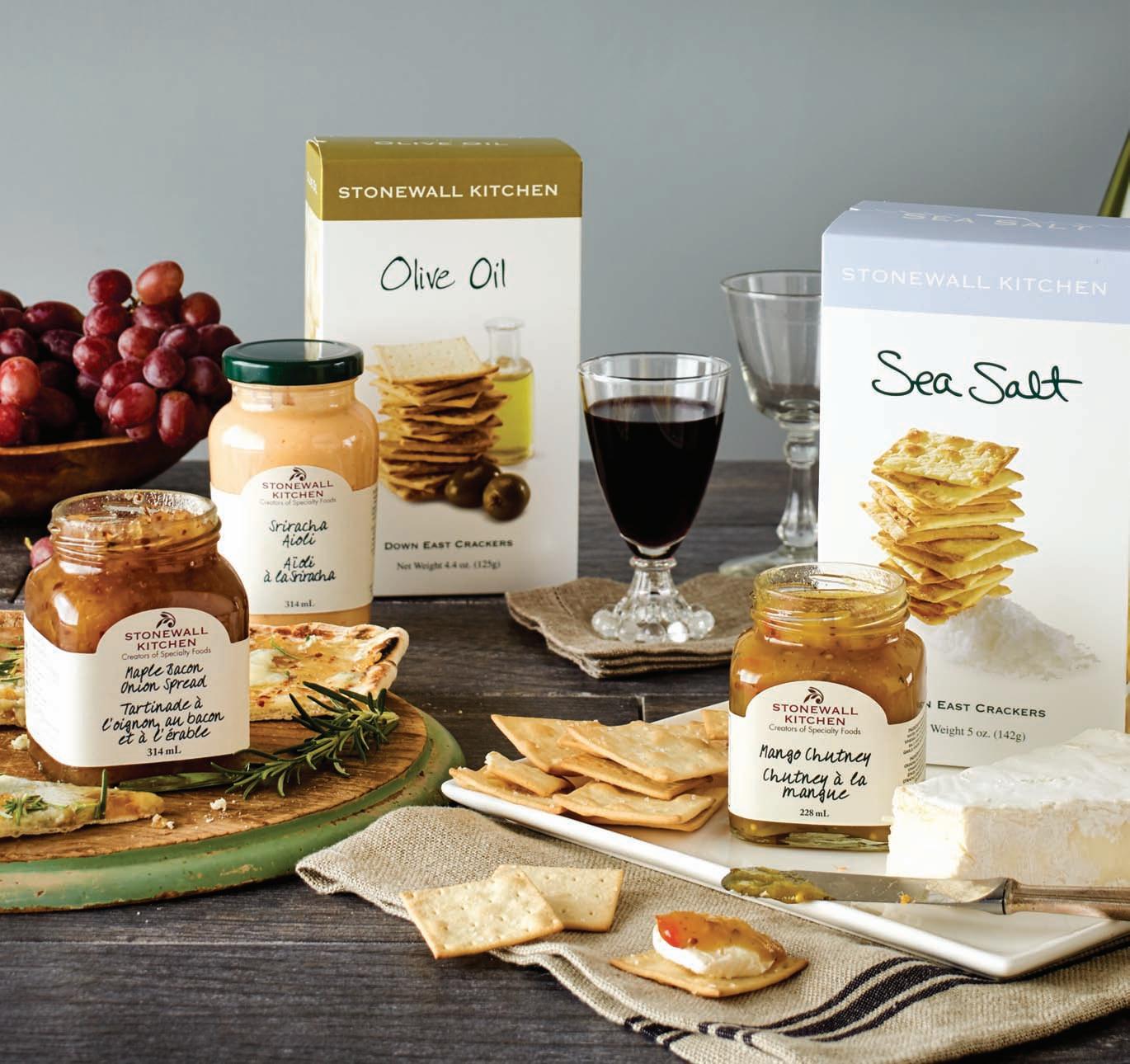



JUST WHEN YOU THINK THERE CAN’T BE ANYTHING MORE GLORIOUS THAN THE SUMMER FRUITS YOU’VE ENJOYED, you taste the first ripe fresh fig in the fall and slip into a state of ecstasy. Biting into a fresh fig is such a transcendent experience that it’s easy to understand why fig trees and their fruits have been considered sacred for thousands of years in many parts of the world. Ancient civilizations were wild about wild figs, and fig trees were one of the earliest cultivated fruit trees. These nutritious morsels have been a treasured tonic food throughout history.
In Asia, the fig tree has symbolized peace, abundance and prosperity since the ancient world. Many cultures revere it as the “tree of life” or the “tree of knowledge.” Figs are a considered a divine food in many religions, and the trees offe r pious Hindus a shady place to meditate. In ancient Rome, the first figs of the harvest were offered to Bacchus, god of wine and fertility. In ancient Greece, Athenians planted hundreds of sacred fig trees in public gardens to thank Ceres, the goddess of agriculture, for these bountiful trees.
If eating a fresh fig isn’t blissful enough, think of this: When you eat a fig, you are eating flowers. The tree doesn’t produce any flowers; its blossoms are contained within its fruit. The fig is unlike any other fruit in this respect. At first, female flowers line the cavity of the hollow fruit. As the fig matures, sweet pulp fills the cavity. The flowers inside ripe figs look like silky strands in the soft flesh. These blooms add a crunchy texture to the moist flesh of dried figs.


No one who has seen the film Women in Love (1969) can forget the comparison of a fig to the “female part…the yoni” or the erotic description and demonstration of the “proper way” to eat a fig. “Split it in four. Open it [into] a glittering, rosy, moist, honeyed, heavy-petalled flower. [Remove] the blossom with your lips.” Or “the vulgar” way: “Put your mouth to the crack and take out the flesh in one bite.” (Watch the “fig sc ene” on YouTube.)
California-grown figs are available from June to October. For locally-grown figs, head to Metchosin’s Blue Haze Farm, North Saanich’s Fruit Trees and More, or Saanichton’s Suntrio Farm and Dan’s Farm, or plant your own tree. The green Desert King variety grows best in our region.

The flavour of fresh figs pairs beautifully with sweet apricots and pears, the saltiness of prosciutto and pancetta, and the pungency of onions and garlic. Yogurt, gorgonzola, brie, blue cheese and crème fraiche are ideal companions. Toss raw figs in a salad with bitter radicchio and peppery arugula. Serve grilled figs with lamb, roasted chicken, or sautéed kale. Poach them in spiced red wine, or bake them into galettes or crostatas. They make fantabulous jam and ice cream worthy of adulation. Best of all, pluck a sun-warmed fig from your tree, and savour it, slowly.
Serves 2


1 lb. of whole-wheat pizza dough
1/4 cup fresh ricotta cheese
Fresh thyme, chopped
3 fresh figs, sliced
Salt and pepper
Olive oil
1 Tbsp honey
Place a pizza stone or an inverted baking sheet on a rack in the top third of the oven. Heat the oven to 450F.
Place stretched dough on parchment paper, sprinkle with thyme and cover with dollops of ricotta and fig slices. Season with salt and pepper and drizzle with olive oil.
Slide the dough on the parchment paper onto the stone or baking sheet. Bake 13 to 15 minutes, until cheese bubbles and the bottom is crisp. Drizzle with honey and serve.

“The four most over-rated things in life are champagne, lobster, anal sex, and picnics.”
—Christopher HitchensOH, THAT CHRIS HITCHENS. I wholly concur with him on the last one and have nothing to say about the third one (if I did, I wouldn’t be saying it here), but he was out to lunch (and breakfast and dinner) on the first two. Especially the second: We’re here not to bury lobster, but to praise it.
What a critter it is, our Atlantic lobster. We cherish the sweet, buttery flesh from its tail, claws and walking legs, the greenish tomalley that functions as liver and pancreas, and the roe or coral, which is black and pasty, but red and waxy when cooked, a touch of finesse for soups and pastas.
Our lobster is a literal blueblood; its bloodstream has no hemoglobin. It can swim backwards at speeds up to 11 miles an hour. It may live as long as 70 years. The largest lobster on record, caught in Nova Scotia, weighed 22.2 kg.
Unlike crab, octopus, squid and shark, lobster has never made a horror movie: Claws is yet to be scripted. Maybe they’ll get Benedict Cumberbatch for it.
As a pillar of gastronomy, lobster’s a latecomer: The New England pilgrims, ever hissing at pleasures of the flesh, used lobsters as fertilizer. American colonial governments were forced to sign contracts promising that indentured servants wouldn’t have to suffer lobster more than three times a week. (B.C. had a similar contract, only here the detested seafood was salmon.)
American restaurants only began to serve lobster in the 1850s, and to serve it for big bucks in the 1920s. The Depression put an end to such luxury, and the crustacean found itself humbled again. In the 1950s, Maritime children who took lobster sandwiches to school were treated as paupers.
Inland, however, lobster staged a stunning comeback. The sumptuous lobster Thermidor, originating in Paris in 1894, its flesh tucked into the tail shell with butter, cheese, wine and brandy, was the ultimate aphrodisiac when I was roving in the 1960s.
Now we live in a simpler age, although it wasn’t that long ago that I ate lobster blanketed in asiago cheese and felt the earth shift under me. And the Toronto RitzCarlton’s fish and chips hit the high notes with ever-so-sweet, tempura-battered chunks of lobster claw.
Today we have a lobster glut on the east coast, driving prices down and prompting lobster fishermen to leave the business. Today’s harvest is estimated at 400 percent of what it was 30 years ago. The experts are stupefied.
It remains Canada’s priciest seafood export, China our fastest-growing market. Seems the Chinese don’t trust their local seafood and prefer their product from unpolluted waters. A lobster’s journey from Halifax to Shanghai takes 50 hours. It’s sold live in restaurants, fish markets and even online with home delivery.
Maybe lobster ’s prestige will help stem the demand for shark’s fin, which provides only the gelatinous texture for a bland, tedious soup assumed to boost sexual potency. The world’s shark population may be annihilated as a result: a few centuries of Chinese cooking vs. 450 million years of evolution.
You won’t find live lobster in Victoria restaurants, although flavour-free frozen product is kept on hand for salads, pastas and playing surf to beef’s turf.
However, the crustacean prince is usually available live and often on sale at Thrifty Foods and the Real Canadian Superstore at less than $10 per pound. That’s when my wife and I pounce: Make that a coupla two-pounders. We steam them for precisely 10 minutes. Nutcrackers, seafood picks and poultry shears enable us to negotiate the carapace. There will be butter, lots of butter, and garlic, too.
And Chardonnay, the biggest, richest Chardonnay we can afford, which is, alas, far from the Puligny-Montrachet that wine writers so blithely urge on the peasantry. But it will be a night to remember anyway, and you’re forgiven, Mr. Hitchens.
thanksto our suppliers, customers + staff for helping us
in 2015, we have donated over $10,000 to local charities from cash donations + in-kind support.
in 2015, we have donated over $10,000 to local charities from cash donations + in-kind support.
For lobster aficionado Jeremy Ferguson, the crustacean is still king.
I HAVE BECOME ENAMOURED OF CORN. I am not talking the cob, whose creamy sweet kernels, regarded as a vegetable, appear at just about every meal the entire month of August, but mature corn, ground into a fine, medium or coarse state or left whole and considered a grain. Road tripping around Washington State fuelled this passion. The Tacos Pihumao truck in Monroe and El Porton restaurant in Zillah dish up meatpacked tacos on light, pliable tortillas that hit the palate with the distinct taste of corn and a certain zing. They are a far cry from the dry, tasteless, commercial-brand discs that had converted me to flour tortillas. (Gloria Latino Market in Bellingham sells very good corn tortillas made on premise.)
Ramping up my fervour in Walla Walla were creamy g rits and tender shrimp, topped with a poached egg—jalapeño cornbread alongside—at Bacon & Eggs, and a black bean and short-ribs sope (thick fried tortilla) from Andrae’s Food Truck. The final piece of the puzzle was finding dried yellow and red hominy at Walla Walla’s Mexican market, Carniceria La Barata.
So what is hominy? Corn kernels that have been soaked in an alkaline solution to remove the hull and germ. The process, called nixtamalization, causes each kernel to swell into what looks rather like a cartoon tooth. It also lends a soda-like tang to a quality tortilla. Hominy is finely ground into masa flour for tortillas. Grits are (mostly) coarse-ground hominy, cooked in milk to a silky porridge. Whole hominy is the backbone of a wonderful hearty soup-stew called posole (or pozole) made (usually) with pork stock and shredded pork shoulder. Garnishes include thin-sliced radish, coriander leaves, sliced avocado, chopped green onion and shredded cabbage. Juicy lime wedges are a must!
Easy-to-prepare posole recipes call for chucking tinned ingredients—hominy and
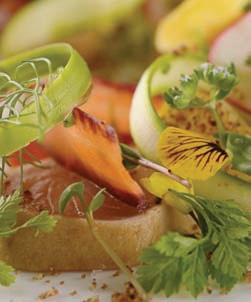
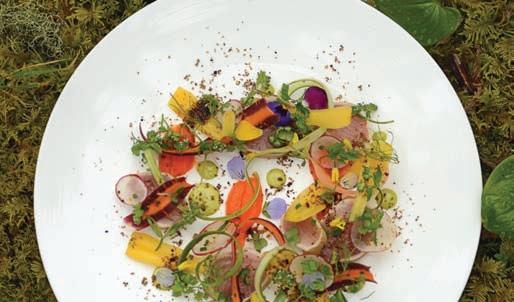
tomatillos, fire-roasted peppers and chiles, and sometimes jarred salsa verde into pork stock. These make perfectly satisfying stews. Recently, though, I made vegetarian posole from scratch with my treasured stash of dried hominy. The process took several hours, was actually rather relaxing, and well worth the time to make. Reconstituting hominy requires a good long overnight soak in water—as you would dried beans—then another two to three hours active simmer in a large pot of unsalted water—to which I added a halved onion, skin on, two carrots and a bay leaf. Poblano and jalapeño pepp ers, a dozen husked tomatillos, and a large quartered onion—all grill-charred—were then whirred about in the food processor with two cups hominy broth (which tasted just like a liquid tortilla), a handful of coriander leaves, toasted cumin seeds, three garlic cloves and a fistful of roasted pepitas (pumpkin seeds). Slow cooked in a Dutch oven for two more hours, the sauce and hominy came together in a rich vibrant posole that was head and shoulders above one made with tinned ingredients. The hominy still retained a chew. (Some kernels were a bit too chewy. The hominy could have soaked and simmered even a bit longer.)
Cornbread made with yellow untreated cornmeal, adapted from Deborah Madison’s Buttermilk Skillet Cornbread, from her 1998 cookbook, The Savory Way, was a delicious add-on. With no buttermilk or cream in the house, I soured regular milk with a dash of vinegar and substituted Mexican crema (you can also substitute sour cream or yogurt) for the cup of cream called for. Grated sharp cheese, chopped red pepper and jalapeños accentuate cornbread nicely. So too did a handful of grated zucchini.
What could be more comforting than a steaming bowl of posole and a wedge of hot cornbread on a nippy autumn evening?
My cornmeal fetish continues. Hushpuppies for pan-fried fish perhaps? Or polenta blanketed with wild mushroom sauce?

Polenta, made by boiling cornmeal into a solidified porridge, was originally made from chestnut flour, chickpeas and ancient grains, but eventually cornmeal became the norm. Strictly speaking, polenta should be made from flint corn. But the same yellow stoneground (medium-grind) cornmeal I use for grits does an excellent job. An evening’s polenta with sausages and peppers is next morning’s grits with poached eggs. I bake and cut any leftover polenta/grits into squares to be served with wild mushroom sauce, another soul-satisfying dish for an autumn night.
Meals are like the punctuation marks of a great trip. They give shape to the narrative of your adventure. We encourage you to explore Tofino and then come visit us at the Wickaninnish Inn to enjoy fresh baked pastries in the morning, a lovingly prepared picnic lunch, or a dinner at The Pointe Restaurant that will put an exclamation point on your time here.
Hominy, grits, tortillas, polenta, posole—corn’s sweet, starchy goodness is the start of a satisfying fall meal.
Coconut Milk
ulas mulas nopr reser rvativespreserva
Tosc Coconut T ca Eastern osca Star form ag age en agen from



have k atives ves ativesnobl leaching bleaching s. sourced ver what coconut over coconut
Tosca Coconut Milk and Tosca Eastern Star Organic Coconut Milk have improved formulas with nopreservatives, nobleaching agents and nosweeteners. Ethically sourced from the Philippines, discover what coconut milk should taste like.

ts nts nosweeteners the disco m taste k

Young chef-owner Rob Cassels’ new restaurant, Saveur, is an exciting, daring star turn on the local fine dining scene. His first restaurant, Flavour at the Ramada Inn on the Gorge, burned down in 2011 after garnering critical praise and a passionate following. Only 27, the strikingly handsome chef took a couple of years for “reflecting, travelling and working.”
He cooked at Charlie Trotter’s in Chicago and worked briefly at a couple of restaurants in Paris before returning to Victoria to open Saveur.
“I came back and started searching. I almost gave up but then found this place and fell in love,” Cassels explained as we visited his new location, the old Viberg boot factory on a quiet, downtown block of Herald Street.
Half of the high-ceilinged room’s long, brick wall has been painted with a metallic, si lver sheen. Dramatically framing the three-person kitchen is a torched-wood back wall. Cassels first saw the charred-wood design, an old house-siding technique used in Japan, at Chicago’s trendy Girl and the Goat.
The room has a gentle, theatrical buzz perfect for the chef’s dramatic culinary creations. “It took a year, but I built everything myself,” the young chef continued, surveying the 35-seat room w ith a contented sigh. Saveur cleverly marries the building’s Old Town heritage to an urbane, very modern decor that includes local painter Irma Soltonovich’s dramatic abstracts on the exposed bricks above the silver metallic paint.
The Victoria-born-and-bred chef’s love for fine dining began early, bussing at his godfather’s restaurant before he was a teenager. Antoine’s, above Centennial Square, was a Vi ctoria fine dining landmark for three decades, and young Cassels worked his way into the kitchen before moving on to a local bakery and other Victoria restaurants. Then he opened Flavour.
Flavour was a sensation, but one week after hosting one of Victoria Guest Services Network’s fine dining samplers, Flavour had a kitchen fire that closed the place down. Then in late June of this year, Saveur opened.
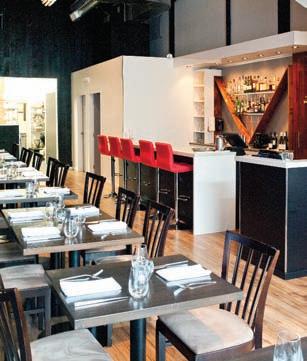
At th e heart of Saveur are the tasting menus
showcasing the chef’s brilliance: a French-style, fivecourse chef’s tasting menu and five-course vegetarian tasting menu. Each offer very thoughtful wine pairings. Saveur also has an exciting à la carte menu and an exquisite bar snacks menu that two weeks into the restaurant’s life were bringing fans back for more of Cassels’ small-plate gems. The chef also collab orates with veteran bartender Chris Aldridge (Irish Times, Upstairs Cabaret, The Duke Saloon) on a handful of “classic cocktails with a contemporary twist.”
I can’t praise his culinary artistry, his use of flavours, textures and inspired technique, too highly. Cassels is a kitchen savant at the top of his form.
My meal matched a Cowichan Valley favourite, Unsworth’s Charme de L’Île Prosecco, with light, Ja panese-inspired tuna tartar followed by a smoky scallop dish with goat cheese melting slowly beside the shellfish and a slight, hazelnut crunch. Both dishes were almost too beautiful to eat, but I took chef’s advice and tried to get all the flavours and textures on each forkful. The Marlborough Sauvignon Blanc complementing the scallops was also spot-on.
Rich duck and pork dishes followed, beautifully pair ed with a deeply resonant Pinot Noir from Kelowna’s Tantalas and a dark but luminous Naramata Cabernet Franc from Nichols. After chef’s Semifreddo with port-like Banyuls, we took a long, leisurely walk through Chinatown, reflecting on one of the best and most creative meals we’ve ever experienced.
Cassels hopes to change his menus often, focussing on fresh, local ingredients and the subtle, French-style s auces he continues to develop.
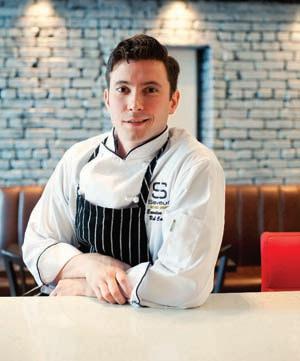
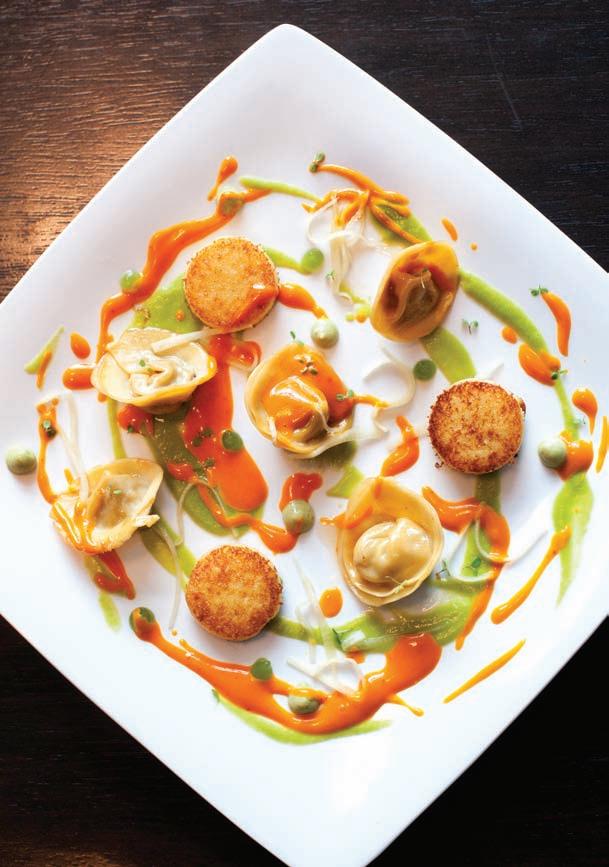
“I think Victoria is ready for a challenging tasting menu,” he explained. “We have such an abundance of great produce, and I’ve always treated vegetables with respect in my cooking. Vegetarians are going to love our tasting menu. I’ve worked very, very hard, lots of long hours and short stints in kitchens where I’ve sucked up as much knowledge as I could. Now I’m bringing it all to Saveur.” BY
JOSEPH BLAKE EWith an ascot-clad duck as its moniker, and French-country and local as the premise, Confit Food and Wine is the latest restaurant in the South Jubilee neighbourhood. The 36-seat space, formerly home to Chez Michel, began its transformation when it sold this past January to Maggie Gong who had recently moved to Victoria from Beijing with her husband and two small children. She kept the menu and hire d a chef to continue the classic French offerings. All the while, she tastefully made over the interior with smoky blue walls offset by mirrors and framed prints of iconic Parisian architecture, adding comfy banquette seating accented with down-filled throw cushions.
In June, when her chef gave notice, it was the Craigslist ad answered by Dwane MacIsaac that inspired another level of change. Chef Mac Isaac, armed with a wealth of experience in the industry, including three years as president of the Island Chefs Collaborative, saw the potential and a need for a menu revamp. During his interview, he put together a concept and logo. Maggie agreed and within two short weeks, MacIsaac and friends set to work and Confit was born. The overgrown back patio was returned to its former glory, revealing a grape arbour. Herb and lettuce gardens were planted and colourful patio furniture was created to accommodate seating outdoors. Indoors, white table linens were removed to reveal walnut-stained tables.




The result is casual elegance and a lunch and dinner menu that draws heavily from local, sustainable and artisanal purveyors. Vic West’s Market Garden, for example, supplies all the vegetables and greens and is showcased in the house salad, a tour-de-force of colour and texture served with house pickles.
On the French side, classic onion soup is luxuriant in a veal demi and red wine broth served with the requisite lid of toasted bread and molten gruyère top. And sweetbreads with morels, rich and creamy from Madeira, shallots and crème fraîche, are served with Fol Epi’s oaten barley bread for dipping.




Duck makes an appearance, not only in the restaurant’s namesake preparation but in the flavourful fat used to roast and fry potatoes. We enjoyed crispy frites alongside moules steamed in wine and lemon with local peas and truffled salami, and returned for lunch for the croque madame, an indulgent stack of ham, melted gruyère and béchamel on Fol Epi boule topped with a fried duck egg. Mains run the way of harissa-marinated lamb chops, grass-fed steaks and seasonal fish. We enjoyed a marvellous whole salt-roasted rockfish under the dappled light of the patio one evening. It was presented and the salty crust cracked open at table. We devoured the tender flesh with a lemon caper aioli and duck-fatroasted fingerlings.
The wine list offers many world picks by glass and bottle, but Maggie, who runs the front of house, will evolve it to herald more B.C. wines and hopefully a few craft brews too! Whatever the occasion, be it a girlfriends’ get together, date night, business lunch or casual evening out, the space is welcoming and confit cozy BY

 SHELORA SHELDAN
SHELORA SHELDAN










1724 Douglas St. | 250-590-7702 | northernquarter.ca



The O Bistro at the Oswego Hotel o ers a unique and dynamic West Coast dining experience unlike any other. Enjoy exquisite local ingredients for intimate dining or chillout with friends and local jazz in the lounge on Wednesdays.
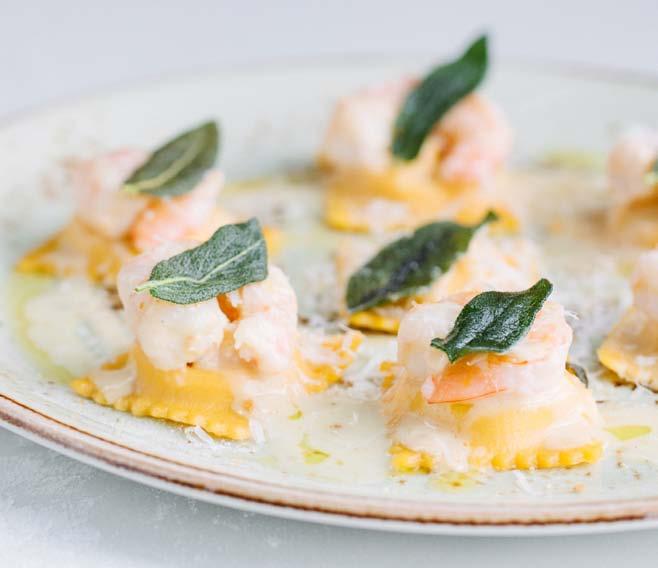
500 Oswego Street | Victoria, BC | T:250.294.7500 | 1.877.767.9346 reservations@oswegovictoria.com | oswegovictoria.com
“I’m enjoying the lavender lemonade. It’s like finding a lemon drop in your grandmother’s linen closet,” stand-up comedian Mary-Ellen Humphries quips. A packed Northern Quarter erupts with laughter. “We may have a sold-out show. Do you mind sharing your table?” asks emcee, frontman and co-owner Benji Duke. My friend Carol-Lynne and I don’t mind. In fact, it’s an unusual and exciting prospect amidst the buzz of a night of stand-up comedy and food.
I am also enjoying the straight lavender lemonade, refreshing, not too sweet and made with local lavender. We order the Toast Trio. Northern Quarters’ in-house baker, Clint Needham, creates a perfect bread: crusty and moist. The Chicken Liver Mousse with Bacon Jam is gamey capped with fatty sweetness, the Olive Fig Tapenade with Goat Cheese is served warm, bringing out the flavour of the figs, softening the cheese. The Ricotta with Schinkenspeck Ham, a Four Quarters Meats smoked German ham, is delish.
Benji Duke (The Fort Street Café) and Torin Egan (The Superior Café) hatched a plan two years ago. Talking with them, their mutual respect is palpable. So is the plain fact that they could not be more different. Benji, with his unbridled enthusiasm and infectious positivity, gushes, “Food is music and art is booze.” Mellow Torin sits back and shares, “Food has to be creative and fun.” They have a third owner, Carlos Marticorena, whose meticulous and elegant woodwork defines Norther Quarter.

My dad and I go for dinner the next week. We order the Barley Arancini from the happyhour menu. The deep-fried balls of barley, mushroom and white Cheddar are crispy, tasty and fun to eat. Next we share the Albacore Tuna Salad with apple, fennel and cilantro-mint vinaigrette and the Baby Back Ribs with blueberry agro dolce (Italian for sweet and sour). It is a succulent privilege to chew the meat off those perfect, berry sweet/sour bones. The tuna is vibrant, surprising. The fish sauce in the vinaigrette contrasts wit h the pickled fennel and bright, sweet, crisp apple. Together with the smooth tuna, the result is outstanding. We finish the meal with the pot de crème served in an antique teacup, topped with sour-cream-laced whipped cream and caramel popcorn. The teacup is a marked shift from the rest of the crockery—pretty, earthy custom pieces from Hands On pottery.
At Northern Quarter, you enjoy an excellent meal or snack with live music, comedy, spoken word and Benji’s famous Quiz Night. The room is beautiful, from the cedar arts installation/sound dispersion piece that forms a wide wave along the ceiling, to the cedarframed baffles and rotating art pieces. The maple and sequoia redwood tables are exquisite, the fine work of Carlos Marticorena. Northern Quarter is food primary so you must eat as well as enjoy your beverages. To miss out on Torin Egan’s food would be missing the star of the show.
BY GILLIE EASDON
Mexico City pulsates with history and chaos, art and design. Even after 20-plus years of travel there, my husband and I still uncover new layers of culture and traditions that beckon us to return. Lately, forward-thinking designers, chefs, artists and artisans have breathed new life into the sprawling capital, creating one of the most exciting and sophisticated centres in the world. On this trip, we depart from our familiar historiccentre stomping ground to explore the culinary scene in the tree-lined neighbourhoods of Roma and Condesa. And who better to guide us than Top Chef Master Rick Bayless and his wife Deann, owners of Chicago’s award-winning Topolobampo, Frontera and Xoco restaurants. In addition to authoring numerous Mexican cookbooks and hosting his TV series Mexico: One Plate at a Time, Rick is an authority on Mexico’s cuisines, both traditional and modern. We share a love of the country, having enjoyed many meals and experiences together over the years. Serendipitously, we were in town on the same weekend, so when their invitation came to “hang out,” we jumped at the chance.
We meet up at the Dardo mezcal festival. The annual outdoor event focusing on regional foods and music is a mind-blowing celebration of mezcal, that ancient elixir that, with its cool branding and packaging, surpasses tequila for hipster cred. It’s also a wonderf ul aperitif, so after some tastings we head for dinner.
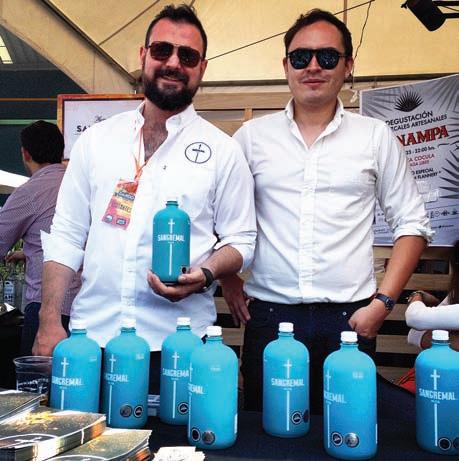
We score a table at Máximo Bistrot. The laid-back room offers a market-driven regional Mexican menu, cooked in a modern French style by chef and co-owner Eduardo Garcia (a.k.a. Lalo), who learned his chops at New York’s Le Bernardin and at Mexico City’s high-powered El Pujol before opening his own place in 2012. “This place reflects Lalo’s passion for incredible local ingredients, and his French, Italian and Mexican training,” says Bayless, looking around at the unpretentious surroundings, the simple wood tables and chairs. We share five dishes, including a tender beef tongue in a robust sauce reminiscent of boeuf bourguignon, and pan-seared fish in a delicate tomatillo sauce highlighted with fava beans, purslane and samphire. “You can’t ca ll it a Mexican restaurant in the traditional sense,” says Bayless, “but its spirit is Mexican through and through.”
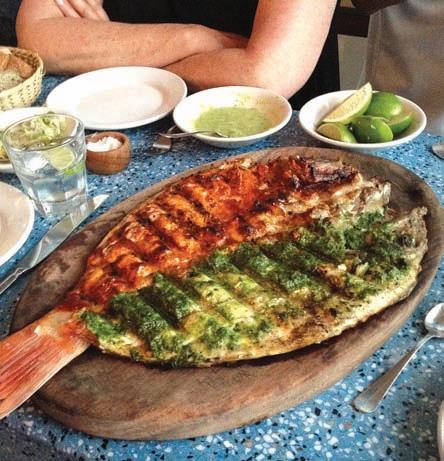
The next morning, the 30-minute wait at Panaderia Rosetta is worth it for chef Elena Reygada’s brilliant pastry and breakfast menu. The cozy, two-floored space, with brick,
rustic-chic chandeliers and mirrors, complements Reygada’s Rosetta, her successful Italian restaurant inspired by a f ive-year apprenticeship with U.K. chef Georgio Locatelli. In 2012, Reygada saw a need for artisan baking in the capital city and opened this rustic, low-ceilinged space. Strong cups of locally roasted coffee work their magic while we order a gustación of pastries: pillowy-soft conchas, cinnamon raisin buns, pulque bread, rolls redolent of rosemary, and a revelatory mille-feuille, layered with cream a nd summer fruits. Huevos rancheros, in a traditional roasted tomato sauce, get a delicious twist with anisey hoja santa leaves and fresh cheese.
To work off breakfast, the four of us head over to Mercado Roma, the city’s newest culinary destination. “This is a beautiful mix of places from chefs who are bringing their love for great food and reclaiming the integrity of Mexico’s culinary traditions,” says Bayless, “and seeing those traditions through 21st-century eyes.” With 60 vendors on two floors, it’s strictly artisanal and farm-to-table with vertical gardens, innovative design and communal tables. Among the highlights: craft breweries, an heirloom seed vendor, cheesemongers, paella, boozy cocktail-infused fruit pops, a stand for churros, a regional and seasonal chocolatier, and hand-pulled torti llas made from heirloom corn varietals. We refresh ourselves at Biergarten on the roof garden with a gin smash made with fresh strawberries, muddled cucumber, balsamic and lime juice before another street walkabout.
Our tour ends at Contramar, where the lines are long for Gabriela Cámara’s seafoodfocused restaurant whose menu takes cues from the Baja. We start with the signature tostada of rosy-hued tuna in a quick marinade of soy, lime and sesame oil, served with fried leeks and sliced avocado, followed by a delicate ceviche of regional chocolate clams with sea asparagus, avocado and olive oil. Waiters weave and dart through the wave of diners, wielding plates of food on oversized service trays. It’s a marvel to behold. Butterflied whole snapper follows, prepared with a parsley-garlic oil on one side and a three-chile paste – redolent of tomato, tomatillos and achiote – on the other. For the finale, we share strawberry parfait cake and a smooth custard tart with fresh figs. Sweet perfection.
We part ways vowing to meet again, perhaps at Christmas, in Oaxaca, a Bayless family tradition. And with a list of other Bayless recommendations in my pocket, I can’t wait to return and uncover yet anothe r layer of deliciousness.
Swans Hotel and Brewpub has been at the heart of Victoria’s Old Town rebirth for more than a quarter century. The late Michael Williams, who died in 2000, was a visionary citizen-developer, philanthropist and important art collector. His properties (all of which were donated to the University of Victoria, including what is now the Legacy Gallery on Yates) house an amazing collection of First Nations art and work of other important local artists. Swans Brewpub is arguably one of the finest small, public galleries in Canada.
Recently, while revisiting the art on the walls and ceiling at Swans, I was struck by Michael Williams’ presence in the room. The work of his artist friends reflected his passion and his image. On one wall there is a beautiful portrait of Michael by Godfrey Stephens, who also carved the m odern, First Nations-inspired pole at the pub’s Wharf Street entrance. Williams supported many local artists. Work by Luis Merino, Jim Gordaneer, Kerry Joe Kelly and stunning carvings by Tom Hunt, John Livingston, Cheryl Samuel and Tony Hunt Sr. give Swans an atmosphere of deep, resonant tradition. Looking out the pub’s wrap-around patio windows in the late afternoon light, I see the
bridge construction, Inner Harbour and old Songhees land and can almost hear the drums echoing across the water 165 years ago.
Above the pub, the hotel’s 30 condo-style suites, also showcasing Williams’ extraordinary art collection, give visitors a rich Victoria experience.
“Michael was very community-minded and deeply concerned about homelessness,” says Theresa Dickinson, Swans’ General Manger, “and as a result my colleague s and I serve lunch at Our Place Homeless Society once a month with the support of the Hotel Association. Another way of keeping Michael’s legacy alive is that we designed an art tour brochure to give visitors some detail on the art in the public spaces. We also printed coasters each with a selection of facts about Mr. Williams, gleaned from some of his closest friends and regulars. I find people are gen uinely interested in our history and our link with UVic.”
Theresa Dickinson has been managing Swans for a year and a half and has gently guided this established property to a brighter future, creating a new culture, inspiring leaders and coaching the 60 colleagues along her journey.

A confident, passionate and well-polished hotelier Theresa’s experience covers Sandals Resorts in Jamaica, Hilton and Meridien in London and California. She also ran a successful hospitality training company in
Cambridge, England for 10 years. Since moving her family to Victoria she has enjoyed working at The Fairmont Empress and Inn at Laurel Point before joining the team at Swans.
"My passion is training and this leadership team has a new energy and vitality towards this property and our most valued asset – our team,” the bri ght-eyed British-Jamaican General Manager explains while giving the server an enthusiastic thumbs-up for her beautifully presented afternoon latte that the team had just been trained to make.
And now, Swans leadership team is complete with the addition of their new executive chef, Jason McMillan. When we met, McMillan had been at the helm of Swans’ kitchen for six months. Earlier in his career, Jason had s pent four years in the kitchen of the Fairmont Jasper Park Lodge. He'd also worked at the Oak Bay Marina and a London, Ontario French-Asian restaurant The Black Trumpet before opening his boutique hotel in Ontario with 40 seat contemporary restaurant. The Esquimalt High grad was keen to move back to Victoria and Swans.
“French cuisine is the basis of everything,” McMillan told me as he sipped one of the pub’s award-winning Pilsners. “Matching my fine dining influences and techniques with our brewmaster Andrew Tessier’s beer has been a blast!” McMillan enthused. “It’s inspired

Michael Williams’ legacy of art and philanthropy gives Swans an atmosphere of deep, resonant tradition.left: The Swans team on the patio. right: Swans motivated leadership team seated with bronze statue of Michael Williams
some new ideas, some new dishes. It’s a learning curve for me, but Andrew has been our brewmaster for eleven years. His craft and passion are inspiring. Our Scotch ale is my favourite to cook with so far,” chef added wistfully while savouring another sip of Pilsner.
1. The Cuban Sandwich: Pulled pork, ham, mustard, pickle and Swiss cheese grilled on a ciabatta bun with Scotch Ale ketchup.
2. Swans Smokey Calamari: Smoked paprika dredged calamari with a Brown Ale gastrique.
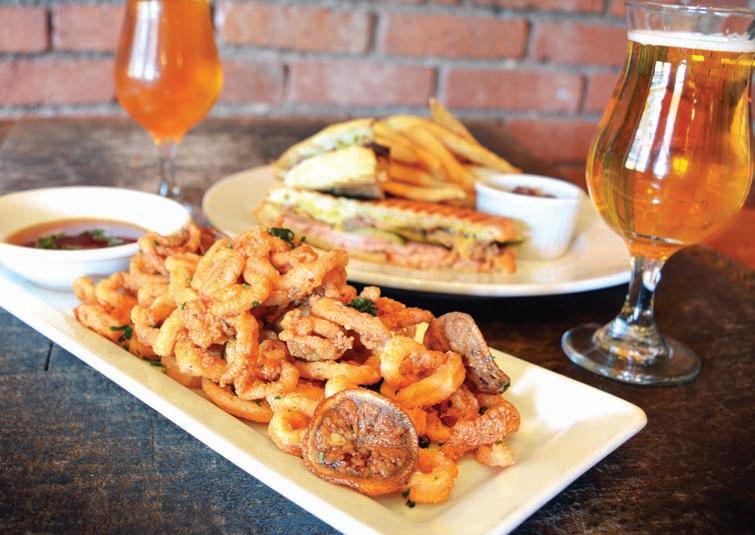
“Andrew’s brews have won 31 awards over the years, and I’m working on beerinfused sauces for our wings. We make in-house Scotch Ale ketchup. I’m also working on a recipe for beer-infused meat balls using our Oatmeal Stout. The selection of beers are also available in bombers at the Swans Beer and Wine store open daily on the Pandora Street side of the hotel.
"With the new bridge and the renovation of the Janion Building, this area along with Swans is ready to take flight, just like Michael used to say, this place was once an ugly duckling, but no more" the grinning general manager explained.
So with the food of Executive Chef Jason McMillan paired with the beer of Brewmaster Andrew Tessier, under the guidance of General Manager Theresa Dickinson I think the late Michael Williams would be proud of his beloved Swans.

Swans Hotel and Brewpub
506 Pandora Ave. 250-361-3310
www.swanshotel.com
Brewpub hours:
Monday-Wednesday 11:30 a.m. to 1 a.m.
Thursday, Friday 1130 a.m. to 2 a.m.
Saturday 9 a.m. to 2 a.m.
Sunday 9 a.m. to midnight
“I’ve got a new dessert menu and a new breakfast menu. I'm using spent-grain from the brewing in the “Swans Stack” buttermilk pancakes that are topped with a full-flavoured Scotch Ale caramel. Daily we bake multi-grain bread with Swans Oatmeal Stout, and season many dishes with herbs from our Penthouse rooftop herb garden."
“I’ve got a good people in the kitchen with high energy and a positive outlook on the changes we have made together. Some have been here many years and a past apprentice from my Ontario kitchen has recently joined me," Chef grins, then continues. “And a young student from Esquimalt High’s cooking program is in our kitchen now too, and that kind of brings everything full circle for a local boy like me.”
I am excited to tr y what Chef Jason will create to pair with one of Swans most popular seasonal releases – the Coconut Porter – coming to the pub and liquor stores in mid-September.
Enjoying one of Swans’ Tasting Nest Samplers (4 for $7, 6 for $9), I listened as Dickinson lovingly described the pub’s regulars. Some come for the food, beer and art, some for conversation, some for the room’s nightly, no-cover charge live music offerings of rock, blues, traditional jazz and country featuring local stars like Bill Johnson, Ange Hehr and Aidan Miller.
A selection of award-winning beers at Swans Hotel & Brewpub
 left: Swans Smokey Calamari right: Theresa Dickinson, Swans General Manger and Executive Chef Jason McMillan
left: Swans Smokey Calamari right: Theresa Dickinson, Swans General Manger and Executive Chef Jason McMillan
These staples come in delectable packages.


This is a little shop with a little menu and a lot oftaste. If you can force yourself past the display case bursting with 30-some cheeses (cheddar with espresso looks interesting), you find a small chalkboard menu with some simple but delicious options. You can get a basic grilled cheese, a fancy grilled cheese, a couple of salads, a lunch platter and soup. These vary from day to day depending on what is in stock. I’m quite fancy, so I tried both the Artichoke Hearts with Jalapeño Havarti and the Roast Turkey Breast with Sun-dried Tomatoes, Aioli and Emmental, each at the nonfancy price of $6.95.
Both paninis had the perfect balance of a crisp exterior and creamy softness inside. The artichoke heart’s natural lemony flavour cut the creaminess just right, and the jalapeño was just a little tingle at the end of every bite. The turkey breast sandwich had a heartier feel thanks to the generous slice of meat and rich aioli. There is always one cabbagebased salad and one bean salad on offer. The Cranberry, Apple and Cabbage Salad was a lovely palate cleanser between bites of cheese thanks to the tart, paper-thin slices of apple and the flat-leaf Italian parsley. A salad can be added to your grilled cheese in a combo for $11.50, or enjoyed on its own for $4.95 or $6.95.

Yet another bargain is the Little Lunch Platter for $11.95, basically a ploughman’s lunch with fresh ciabatta, two featured cheeses—mine were

Smoked Apple Cheddar and French Bleu d’Auvergne—a meat, cornichons, black olives, a fruit and nut mélange and a perfect tapenade made with sun-dried tomatoes. This can be easily packed into a picnic for a park outing. Some cheese devotees may remember this space as once being Hilary’s Cheese. New owner Lauren Van Der Haegen used to work for Hilary, and in the fall serves soups made by Hilary’s wife, Patty. You can’t get more “island food” than that. And island cheeses on offer include ones from The Creamery at Cheese Point Farm in Cowichan, Natural Pastures Buffalo Milk Cheeses, and Salt Spring Island Cheese.
***Listen to Elizabeth Monk on Kool 107.3 radio at 8:05 am, Wed, Sept 8th E

Cont’d next page




left: Cold Smoked Tuna Taco Plate with salsa, cabbage slaw and chipotle mayo right: Halibut fish and chips, served with housemade tartar and kennebec fries


27 Erie St. near Fisherman’s Wharf, 250.383.7760
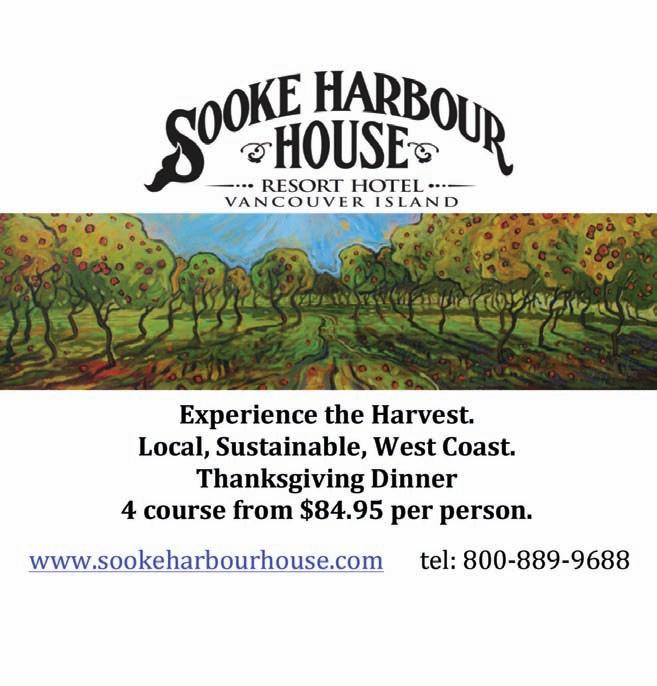
Like a child at Christmas who received too many presents and just ends up sitting there, numb, I find it hard to know where to start in describing the Finest at Sea Food Cart. Choices range from fish and chips to tacos to soup to burgers to a daily special such as miso-glazed sablefish, tragically sold out on the day of my visit. I will rally myself by starting with a classic: fish and chips. The halibut, crème de la crème of battered fish fillers, is a juicy, tender, four-ounce piece in a batter crispy enough I had to pierce it with my fork and piquant thanks to lashings of black pepper and garlic. The Kennebec potato fries, hand-cut and par-fried before cooking, end up doubly crispy. The tartar sauce, with its fresh dill, lemon and garlic, is not sharp and aggressive like a horrible one from a giant bin.
Go top of the line with halibut for $15, or choose salmon or lingcod ($11 for one piece with fries). A cold-smoked tuna taco plate ($9) has two overflowing flour tortillas stuffed with tomato-corn salsa, coleslaw and chipotle mayo on top of the smoky tuna. This dish has a lot of vegetables for the digestion-aware and just spicy enough to wake up your taste buds. The New England Chowder ($7 for 16 ounces), packed with halibut, salmon, shrimp and smoked fish, is made to order every time. Fresh herbs are the top, forward flavour, with dill making a definitive appearance. The Finest at Sea shop has expanded to include take-home items like lobster croquette, tuna arancini and B.C. salmon pot pie. Or, instead of taking food home, you could just never leave.

Cont’d next page
OLO is a farm-to-table restaurant with a focus on local, sustainably raised ingredients, complemented by an impressive beverage list and perfectly mixed cocktails.
Open seven days a week & late night Sunday to Thursday 5pm – 12am

Friday and Saturday 5pm – 1am
509 Fisgard Street, Victoria, BC (250) 590-8795 | www.olorestaurant.com
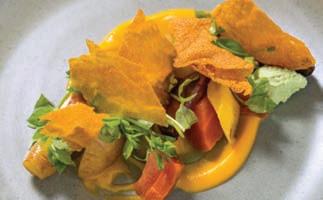
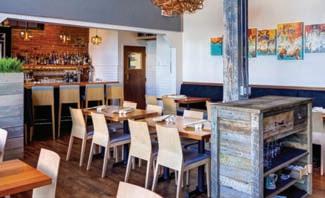



250-383-1545

left: Zereshk Polo - Chicken leg and thigh served with barberry and saffron topped rice right: The inside of the grocery

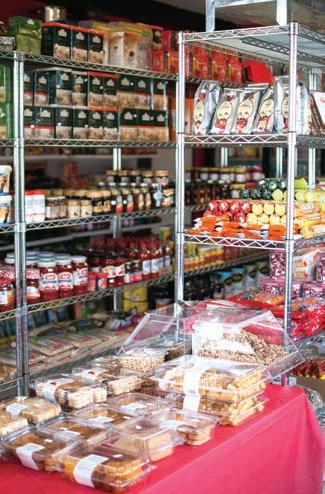
3949 Quadra at Reynolds | 250-590-6020
At this Persian mom ’n’ pop shop, you can buy Middle Eastern groceries and also enjoy the lunch of the day. You have one option per day, but my three visits on different, carefully orchestrated days of the week indicate that you will get something tasty no matter the day. Tuesday is Zereshk Polo day (polo means pilaf). At only $7.99, it is as pleasing to the eye as it is to the mouth. Chicken is seasoned with paprika, turmeric and saffron and slow-cooked in its own juices—no water—which intensifies the flavour. It is served atop a bed of mixed white rice and sunny yellow saffron rice and is sprinkled with red barberries. This exotic ingredient is from a bush native to the Middle East. The chefs and owners Nooshin and Nasser dust these sour berries with sugar, creating a pleasing sweet and sour accent, as if a dried cranberry
were dipped in lemon. The dried berries can be bought at the shop by enterprising home cooks. On Thursdays, Loubia Polo can be had for $6.99. This green bean and ground beef rice pilaf has the feel and comfort of a classic 1970s Canadian casserole. The ingredients are mixed in a sauce of tomato and turmeric, which coats each grain of rice nicely. Friday is the day to splash out with Baghali Polo, dill-flecked rice and fava beans served with either chicken ($7.99) or lamb shank ($10.99). The lamb is so tender that, with the touch of a fork, the meat falls off the bone. The thinly sliced fava beans impart a nutty taste and texture, making this a mild but interesting dish. Most business is take-out, but there are four seats at a bar and some tables outdoors in good weather.
Local Beverage Producers & Restaurants at the Midlife Crisis Show Saturday Oct 3, noon – 5 pm
The Midlife Crisis show takes Oct 2 & 3 in Victoria at theVictoria Conference Centre. As part of the event a Tasting Room will be set up where attendees can sample food and drink pairings from area food and beverage businesses. Here’s what’s on.
• Sea Cider Farm & Ciderhouse is paired with Chateau Victoria’s Vista 18 Restaurant, Executive Chef Garrett Schack
• Moon Under Water Brewery & Pub is paired wi th Kitchens of Distinction Culinary Arts, Chef Shirley Lang
• Unsworth Vineyard & Restaurant is paired with The 6 Mile Pub, Chef Jeff Kelland

Victoria Spirits is paired with Charelli’s Cheese Shop, Delicatessen & Catering
• 2% Jazz Coffee is paired with Olive The Senses
Anteeo Tea Company is paired with Crumsby’s Cupcake Café
• Jusu Bar is not paired because cold pressed juice is ideally consumed by itself
• Fairway Market International Food Fair is all it needs to be by itself. Tickets can be purchased at midlifecrisisshow.com/tickets
For this issue, we asked women in the food industry to answer the following question: Which local chef, farmer or food producer inspires you and the work that you do? Tell us why.

Daniela Cubelic, Tea Master & Owner, Silk Road Tea


The talented Crystal Duck, who is the chocolatier at Spinnakers, always inspires me with the creativity of flavour combinations in her chocolates. She showcases local ingredients at their seasonal best, and breathes new life into more traditional pairings as well. Her chocolate truffles are often unique but not for the sake of shock valuethe combinations are very harmonious to the palate, and are often pleasingly complex and layered in terms of taste and texture. The skill and effort she puts into her work, along with the joy she applies to her craft shine through.
Maryanne Carmack, Co-owner/Director of Operations, Roast
Salt Spring Island Sprouts & Mushrooms is a small-scale food producer from Salt Spring Island, growing the freshest sprouts and mushrooms year round! Canadian grown, certified organic seed and spawn, creating amazing products delivered right to your door within 24 hours of harvest. Their products are always fresh and vibrant, and they offer an amazing array of options. They inspire me because they farm from the heart with a strong sense of integrity and community.
Rebecca Teskey, Co-owner, The Village Butcher



I admire Tom Henry of Stillmeadow Farm and John Buchanan of Perry Bay Sheep Farm. Together, they provide us with pigs, lambs and chickens. While they each have their own farms John and Tom work closely with one another, proving that symbiotic relationships don't just exist on the farm, but also between neighbours and communities. Helping each other, sharing responsibilities and resources creates a stronger system, allowing them to produce more than would be possible alone. They inspire me to remember that we are all a team in the effort to create a strong local food security.marbling time to dissolve into the meat.
Jennifer
I cannot put my finger on only one person that inspires me. It is definitely the cumulative efforts of every local grower/farmer that is choosing to grow organically. The commitment to providing the best food without the use of chemicals that are harmful to our health and the environment, this is a hard road to travel with little support. Organic Farmers inspire me and this is reflected in the choices on offer at the store.


As someone who has worked with many great chefs in the past I would have to say the one I find most inspirational would have to be the lovely Ali Ryan of Spinnakers. I have had the pleasure of working with her as President of the Island Chefs Collaborative for the last few months and there really is no one else in the Industry that works as hard to promote and utilize our local products and producers. She has personal relationships with all of her producers that I admire because fostering those relationships takes time, a commodity she has very little of. On top of that she volunteers tirelessly and always with a smile. I know that Ali considers what she does important and so do I. That inspires me.



 By Sharon McLean
By Sharon McLean

Wine will flow at the second annual Victoria International Wine Festival on September 25 and 26, when the Parkside Hotel and Spa is transformed into a mecca for wine lovers.
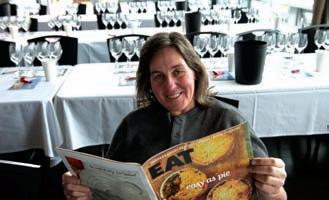
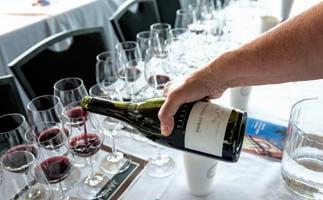
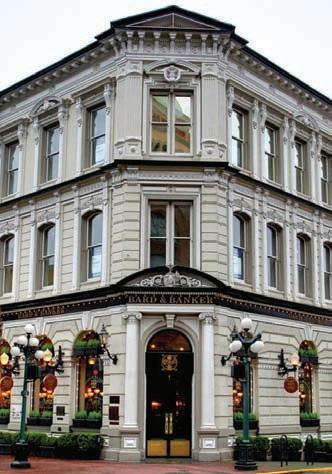

The Festival is for anyone who enjoys wine and wants to learn more. Dave Bain, the driving force behind the Festival, observed many people in Victoria wanting to explore wine, but not knowing where to start. With eleven years’ experience in event planning, he saw a perfect opportunity to create somewhere for those people to come together, to taste, and to learn.
Bain set out to create an environment where people would feel welcome, ask questions, and talk about wine. It seems he was successful. The majority of people who attended last year ’s inaugural Festival were average consumers and Bain was happy that the response was fantastic. So, he's doing it again. Just bigger and better.
The Festival remains unabashedly international in focus. Bain notes that when consumers walk into a liquor store, they are faced with hundreds of options from around the globe. The Festival deliberately reflects that reality and gives people a chance to taste the differences and learn for themselves what to expect from each region.
There will be three public tastings over the two days of the Festival. The capacity at these main events has increased from last year and there will be over thirty tables, each pouring 6-8 wines. A tasting room with that many wines can be daunting. Jacques Lacoste, one of the Festival sommeliers, advises to keep an open mind, f orget old standbys, and try something new. Bain notes that last year, some people opted to focus on just whites, or just reds. Whatever the tasting strategy, the risks are minimal when it’s perfectly acceptable to spit like a pro.
For those looking for a more in-depth educational experience, the Festival also offers three public seminars with renowned speakers. Details have yet to released, but two th emes have been announced: one will feature the iconic Caymus wines from the Wagner Family in Napa Valley; and a second will offer Speed Pairing, where participants explore the factors that can make or break a food and wine pairing. Bain reports that the seminars were extremely popular last year, with the California versus Australia seminar selling out quickly and the participants enjoying some lively discussions. All the seminars will be held in the top floor room at the Parkside, where the floor to ceiling windows provide a stunning backdrop.
New for this year is a pop-up liquor store. Operated by Vintage Spirits, the store will allow attendees to purchase or order wines that they fall in love with at the Festival.
With this year’s Festival well in hand, Bain is looking to the future. He plans to grow the Festival, attracting world-recognized presenters and promoting Victoria’s reputation as an international city. Clearly, there is more to come.
Tickets for the main events are on sale now and can be bought online at www.viwf.com or in person at Vintage Spirits, 653 Pandora Ave or the Parkside Hotel and Spa, 810 Humboldt Street. The Parkside Hotel is also offering special packages for those wish ing to stay at the hotel.
Event details can be found on the Victoria Wine Festival Facebook page or at vicwf.com . The festival is sponsored in part by EAT Magazine By Sharon McLean








G Hynes
Holiday spices warm up the pre-winter cocktail scene.
fortunate to have a remarkable tea shop in the form of Silk Road with its endless teas and possibilities bursting at the seams of the store. Teas can be used in many ways: in syrups, shrubs, tinctures, f oams, sodas, ice cubes and infusions. My imagination swirls with ideas the moment I enter the Government Street store. Iced tea has been a staple for the summer, but when the chillier months descend on us, Silk Road’s seasonal teas are called for.
left: Barrel Flower
right: Equinoxe Toddy

As the clouds close in and the temperature drops, the aromas of cinnamon, anise, cloves and nutmeg begin to fill the air with their spicy warmth. These classic flavours are synonymous with autumn and that feel of homeyness many of us remember from our childhood. Spice has been used in cocktails since before the word “cocktail” was invented. Spiced rum grog, mulled wine, spiced ales and spiced rums—all have had their place in the history of alcoholic drinks.
Tea, especially spiced tea, is an amazing and sometimes under-utilized cocktail ingredient. In Victoria, we are very



2 oz Odd Society Oaked Wallflower Gin
1/3 oz Silk Road Chai Tea Syrup (recipe below)
Dashes of Bittered Sling Malagasy Chocolate bitters
Glass: Old fashioned
Method: Stir and strain over 1-inch-by-1-inch cubes.

Garnish: Lemon twist
EQUINOXE


1½ oz Lot 40 Whisky
½ oz Suze Liqueur
½ oz lemon juice
½ oz simple syrup
Top with Snow Apple Spice Soda (see below) or hot brewed tea

The recipes I’ve included below showcase the autumn nuances I want to taste in my drinks using Silk Road teas such as Chai and Snow Apple Spice. The Barrel Flow er uses Wallflower Oaked Gin as a base in an old-fashioned variant. Build on this with the Silk Road Chai Tea Syrup and Malagasy Chocolate Bitters from Bittered Sling, a retail line of highquality, small-batch bitters from Vancouver. Put them together and you have a strong, spirit-forward drink for predinner. The second drink, the Équinoxe Toddy, is a play on the French translation of equinox, the tim e of year when the day and night are of equal lengths. The reasoning here is that this drink can be served cold during the day or warm at night. Fall drinks don’t need to be boring; they can be fun, tasty and satisfy your desire for autumn in a glass. E
CHAI TEA SYRUP
1000 g Turbinado sugar
750 g water

25 g chai tea
Method: Dissolve water and sugar over a low heat till sugar is dissolv ed. Bring temperature up to 85°C, turn off and add tea. Let steep for five minutes. Strain and bottle. Keep refrigerated.
Glass: High ball for cold; heat-proof mug for hot
Method: Shake all ingredients and top with either ice and soda* or hot tea.
Garnish: Lemon wheel and cinnamon stick


Our five top picks for satisfy your urge for moules.
Here in BC, the most common species of mussels produced are the sweet, plump Atlantic Blue or PEI (Mytilus edulis) and the Gallo/Mediterranean mussel (Mytilus galloprovincialis). The main supplier for commercial mussels is Saltspring Island Sea Farms (saltspringislandmussels.com). In 2005, this team created a hybrid of the two species, whi ch resulted in an unusually plump, sweet, meat-filled variety. The hatchery is “Ocean Wise” certified and uses mesh sleeves (socks) attached to long line systems (ropes) to grow the mussels until they mature and reach market size (a period of 18 months to 3 years).
Eaten in a variety of ways, mussels are steamed, baked, barbequed, fried, and smoked, though steaming is one of the most common ways to prepare mussels. They are delicious prepared with a variety of flavours. Steaming them in a rich tomato (or beer) based broth—along with a few onions and garlic—is the classic method. Alternatively, create a creamy white wine stock with butter and herbs, or spice it up with a little coconut, ginger, lemongrass, and chili. Serve with crusty bread to soak up the reserve liquid or pair the dish with crispy French fri es (moules-frites).
Canoe Brewpub (canoebrewpub.com) is a favourite for mussels and handcrafted beer. Located at the foot of Victoria’s historic Chinatown and overlooking the inner harbour, patrons rave about the house mussels, which are prepared in a Canoe lager, garlic, leeks, chili, tomato, flat leaf parsley, and crouton ($16.50). Kick it up a no tch more by adding fries & rouille ($2.50). Take advantage of this weather and enjoy your mussels on the waterfront patio.
It doesn’t get much fresher than Ferris’ Oyster Bar & Grill (ferrisoysterbar.com). While their oysters are a long time favourite among patrons, Ferris’ mussels are an excellent choice if you’re looking for a big ol’ bowl of delicious. The restaurant serves their mussels two ways: steame d in a spicy Malaysian coconut
curry; or classic style with white wine, butter, garlic, fresh tomatoes and lemon. Pair either with an order of the house fries and the triples dip and you’ll be happy as a clam or… a mussel. Halfpound servings ($11.00) and full pound servings ($17.00) are offered.
Dining at Il Terrazzo Ristorante (ilterrazzo.com) is an experience—the old town courtyard setting, brick firepl aces, and candlelight set the mood while the food becomes the journey. The cozze (mussels) are a popular menu item with guests, and are an excellent sharing dish as a starter to your meal. The mussels are sautéed with sun-dried tomatoes, banana peppers, roasted garlic, white wine, and red onion and finished with fresh squeezed lime and asiago ($17.00). The peppers add just the right amount of heat. Try pairi ng these mussels with a clean, crisp and dry Riesling.
Santiago’s Cafe (660 Oswego St., Victoria) is located at the foot of James Bay and is within walking distance from downtown. It’s a great place for lunch, to bring the family, or to enjoy a nice quiet dinner with your significant other. They offer mussels done three ways: Spicy Chipotle with smoked chilies, sun-dried tomatoes, garlic, and onions with white wine and cream; Thai with coconut milk, red onions, cilantro, bell peppers, grated fresh lemon, sweet chili sauce, and sesame oil, finished with white wine and cream; or Fresh Lemon with red onions, garlic, fresh tomatoes, fresh lemon, and cilantro, then finished with white wine and butter. Each order of mussels is served with garlic butter and fresh bread ($16.95). Add a side of rice, squash, or papas bravas to make it a complete meal. Located in the heart of Fernwood you’ll find Stage Wine Bar (stagewinebar.com), a true gem. When you treat yourself to a Stage experience, all your needs are met, from the atmosphere to the knowledgeable and friendly staff to the exceptional food and wine list. The Cortes Island mussels are simply heavenly too, cooked to perfection in a creamy broth of smoky chipotle, coconut, cilantro, and ginger ($13.25). These mussels are delicious on their own, though snacking on a side of the house pommes frites doesn’t hurt.
Board Certified Dermatologist and UBC Faculty Clinical Instructor, Dr. Mark Lupin MD FRCPC, and the skincare experts at Cosmedica provide unparalleled service and experience. Trust in the hands of true experts for the most natural and beautiful results.







The thing about pizza is, it’s the food version of your LLBFF. It’s the go-to meal (and emotional support; I eat my feelings) for everything from Friday dinner to date night and that late night after hours craving—with leftovers for breakfast. Give your pie an autumnal makeover with sweet golden squash and of course, always put an egg on it.
Makes 6 individual pizzas
1 2/3 cups hot water
1 Tbsp honey
1-8 g pkg traditional dry yeast
1 Tbsp olive oil
3½ cups all-purpose flour
¼ cup whole wheat flour
1 tsp sea salt
1½ tsp chopped fresh rosemary or thyme
In a small bowl, whisk water with honey until dissolved. Let cool until lukewarm. Stir in yeast and let sit for 5 minutes or until mixture bubbles. Stir in oil. Place flours, salt and rosemary in the bowl of a standing mixer fitted with a dough hook. Set mixer to low and gradually add in yeast mixture. Mix until dough is firm and smooth, about 10 minutes.
With floured hands, remove dough to the counter. Cut into 6 pieces and then form into balls. Space three balls each on two large baking sheets lined with parchment paper. Brush balls with oil, then loosely cover with plastic . Place in a warm spot and let rise until doubled in size, about 2 hours.
Punch dough down. If not using right away, portion into individual plastic bags and refrigerate overnight or freeze up to 1 month. Bring to room temperature before using.
To form pizza bases, lightly coat your hands with flour and dust counter with flour. Working with one ball at a time, use your fingertips to press dough down and spread out. When dough has doubled in width, use a rolling pin, and roll to into thin flat rounds or rectangles.
Sprinkle baking sheets (keep parchment) with cornmeal and place dough on sheets—three per sheet. Ready for topping!
Makes 6 servings
1 large butternut squash, peeled and seeded
2 garlic cloves (unpeeled)
1 Tbsp olive oil
Sea salt
500 g tub ricotta cheese
1 tsp julienned preserved lemon
¼ tsp ground nutmeg
6 prepared pizza dough discs
½ cup sage oil*
Grated Parmesan cheese
6 fried eggs
Fried sage leaves*

Handful of fresh basil leaves
Thinly slice squash. (Tip: First cut into smaller pieces, then slice on a mandolin). Place in a bowl and add garlic. Toss with oil and salt. Spread out on 1 or 2 baking sheets and bake in 350°F oven until squash and garlic are tender, 12 to 15 minutes. If making ahead, cool and then wrap squash. Refrigerate overnight.
Stir ricotta with lemon and nutmeg. When garlic is cool enough to handle, squeeze out from papery skins. Mash, then stir into ricotta.
Brush rolled pizza dough with sage oil, then evenly spoon ricotta mixture overtop. Top with squash slices. Generously grate Parmesan overtop (eyeball it to your liking). Bake in preheated 475°F oven until dough is golden around edges and cheese melts, about 8 to 10 minutes. Top each pizza with a fried egg and crumble with fried sage leaves. Finish with fresh basil.
Strip leaves from 1 big bunch of sage. Heat about ½ cup olive oil in a frying pan set over medium-high heat. When hot, fry 6 to 8 sage leaves at a time until crispy, about 5 secs. Carefully remove to paper towels and generously sprinkle with sea salt. Cool oil, then strain. Use oil for pizza base and crispy sage leaves for garnish.
Hope for leftover sauce. It's great on pancakes and waffles too!

You don’t really need a reason to eat dessert, but if you’re looking for one, just say you’re eating your veggies.
Tender nuggets of roasted winter squash are tucked inside this cake for a golden surprise. But beware! This is an über-sweet, dense dessert. Serve with a strong cup of coffee to cut the richness. Not for the faint-hearted!
Cake
3 cups all-purpose flour
1 tsp baking soda
1 tsp each ground cinnamon and sea salt
1¼ cups vegetable oil
2 cups granulated sugar
3 large eggs
1 tsp vanilla extract
3 cups cooked diced butternut squash

Toffee Glaze
½ cup butter
¼ cup whipping cream
1 cup brown sugar
2 Tbsp orange liqueur
1 tsp vanilla extract
Toffee Sauce
1½ cups granulated sugar
½ tsp ground cinnamon
½ cup water
¾ cup cream
2 Tbsp butter
2 Tbsp orange liqueur
To make the cake, generously oil a Bundt pan. In a bowl, whisk flour with baking soda, cinnamon and salt. In the bowl of a standing mixer, beat oil with sugar. Beat in eggs, one at a time, then vanilla.
Add flour mixture and beat until smooth. Fold in squash. Scrape batter into prepared pan and bake in lower third of preheated 325°F oven until a toothpick inserted in centre of cake comes out clean, about 1 hour.
Meanwhile, make the glaze. Melt butter in a saucepan. Stir in cream and brown sugar. Bring to a boil over moderate heat, stirring often. Remove from heat and stir in liqueur and vanilla.
Let cake cool for 15 minutes, then using a skewer, poke about 15-20 holes in surface. Po ur hot glaze over cake (still in Bundt pan) and let it seep into cake. Cool completely, about 1½ to 2 hours, and then invert onto a serving plate.
To make the toffee sauce, in a saucepan, stir sugar with cinnamon and water. Bring to boil over medium heat, stirring until sugar completely dissolves. Gently simmer, occasionally swirling pan until bubbles form and mixture turns deep amber, about 8 minutes. Carefully stir in cream and butter. Remove from heat and stir in liqueur.
To serve, slice cake into wedges. Top with whipped cream or ice cream (if you dare) and drizzle with toffee sauce.
Text, recipes by JENNIFER
Food styling by JENNIFER
DANTER DANTERPhotography by MICHAEL TOURIGNY
Art Direction by JENNIFER DANTER & GARY HYNES
Duck,once confined to high-end restaurants, is turning up on casualdiningmenus
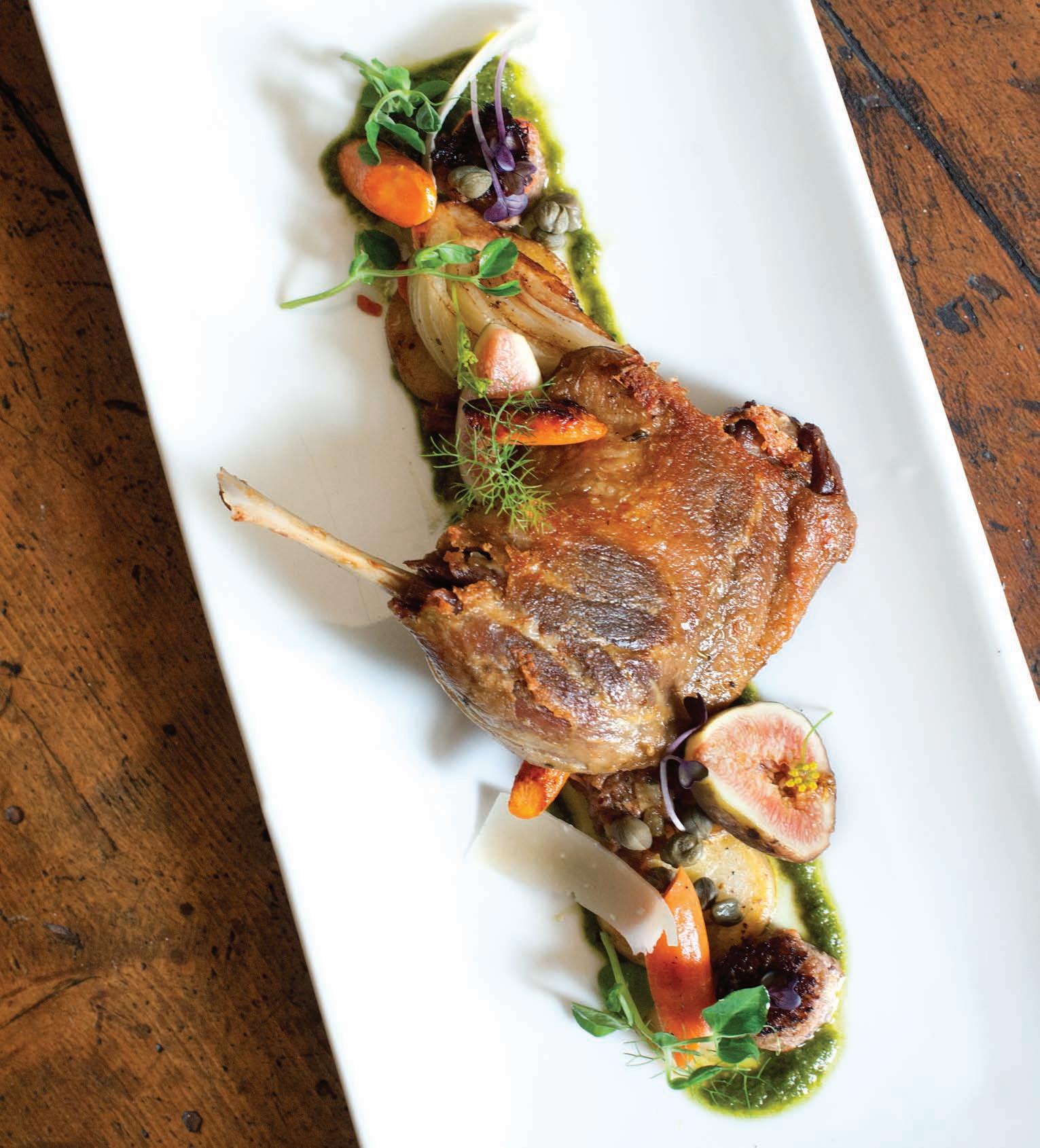
IT’S NO
world’s most celebrated chefs named one of the world’s most celebrated restaurants The Fat Duck. (Heston Blumenthal’s famous eatery 60 miles west of London, UK.)
Evoking both the nostalgia of nursery rhymes and that unctuous and unique treat known as “fat liver” (foie gras), the words waddle across the tongue and make us smile, our mouths watering at the thought of rare duck breasts, melting confit and crisp potatoes cooked in this tasty bird’s ample oils.
The dark, flavourful meat is rich and usually expensive, especially outside traditional duckproducing regions, which may be part of its cachet.
Duck breasts are a dime a dozen in the south of France. I remember joining a harvest dinner for workers in a Bordeaux vineyard where dozens of magret were grilled over big fires of smoldering vines, the way we might grill burgers for a casual barbecue. And while duck is still rather exotic on this side of the pond, it’s more popular than ever.
Until quite recently, most of the duck we consumed in Cana da was at high-end restaurants or Chinese barbecue joints, the former usually the fat breasts from Quebec’s Brome Lake, the latter a mahogany-glazed bird hanging by the neck in a Chinatown storefront.
But a new generation of chefs has democratized the duck, introducing the bird to diners in bold new ways. Here in Victoria that means Buck a Duck wing nights, creamy duck rillettes to slather on toast and tender duck legs popping up on all kinds of casual menus.
Traditionally, wherever you find foie gras production, you’ll find duck—whether it’s in the Dordogne region of southern France or the eastern townships of southern Quebec. Duck confit is a classic ingredient in French cassoulet, the tough legs slowly braised in duck fat until tender, with the more valuable breast (magret) sold to chefs.
In France, that breast comes from the fatter Moulard duck, but here in North America it’s likely a lankier Pekin duck (a.k.a., Long Island duck), a bird raised specifically for meat production (not foie gras).
Brome Lake Ducks, a company in Knowlton, Quebec, has been raising and processing meat birds for more

The rich, flavourful meat is turning up on menus in all its succulent guises
left:Braisedduckwings,househotsauceatNorth48Rсtaurant


than 100 years, the standard for restaurant chefs and now available in supermarkets from coast to coast. Brome Lake specializes in young Pekin cross ducks, six to seven weeks old (not foie gras production), and has recently launched a consumer line of frozen duck products under the Oh! Canard label.
Brome Lake Ducks has vastly expanded its production, now raising 2.2 million ducks a year, which may be at least part of the reason why duck is finding more fans outside Quebec and is available at many restaurants and retailers.
Here on the west coast, the main duck and geese producer is Fraser Valley Specialty Poultry (FVSP) in Chilliwack. Their ducks are free-range, naturally raised birds and slightly more expensive than their French-Canadian counterparts. FVSP sells its duck and goose products at wholesa le to restaurants and also has a farm store offering everything from duck burgers and lean ground duck to smoked duck breast and duck pepperoni.
But that’s the only B.C. duck you’ll likely find on local menus or at retail because there’s no longer a facility on the island that processes ducks.
At the Village Butcher in Oak Bay, Rebecca Teskey and Mike Windle feature Fraser Valley ducks. You’ll find whole ducks in their freezer, as well as frozen Yarrow Meadow breasts and legs and even half-litre containers of duck fat to make confit at home.
“Duck fat is popular—people buy it like crazy,” says Windle, who also sells housemade duck confit and smoked duck breast that’s ready to eat.
Or you can head to Choux Choux Charcuterie, where they prepare duck and cranberry terrine, Parfait de Canard, duck rillette and foie gras mousse with black truffles and have duck fat and Yarrow Meadows duck breasts for sale in their freezer.
Whether it’s the duck confit hash for breakfast at The Ruby or the duck wings and beer happy hour at North 48, everyone is doing duck. At the apex of this duck dynasty in Victoria is chef Jesse Cole at Little Jumbo. Duck is more than a menu item at this popular downtown speakeasy. Cole oversees a complete “duck program” in his restaurant kitchen, one that sees whole birds browned down into their many tasty parts, then cured, dried, cooked in sous vide baths or buckets of duck fat, braised for stocks and duck purees, or seared to pink perfection.
“I’ve always ordered whole ducks, the Fraser Valley Yarrow Meadows duck,” says Cole, who serves duck rillette with his own marmalade, duck liver and foie gras parfait, duck breast with fondant potatoes braised in duck fat, crispy smoked duck wings and duck confit with creamy cabbage.
“We’re a small kitchen so we have to use everything,” says Cole of his à la cart duck dishes and Big Duck board, a whole duck in all of its guises, served on a platter for just $70. “It’s a real bargain and people love to share it,” he say s.
With its French pedigree, duck is always on the menu at Ça Va Bistro Moderne, Vis á Vis Bouchon and Brasserie L’Ecole. The newest duck diner on the block is Confit—a happy duck in a sporty cravat on the sign outside the Oak Bay eatery. Chef Dwane MacIsaac is behind the bistro-inspired menu (in the former Chez Michel space). The seared duck breast with berry balsamic reduction from the last menu has been replaced by MacIsaac’s confit of duck leg, with Okanagan cherry gastrique, but it’s all in the French tradition.
“Duck is classic French fare and affordable, too,” says the chef who is also using local duck eggs in his chocolate espresso duck yolk pot au crème and fried on his croque madame sandwiches, serving duck confit atop green salads for lunch, and offering mussels with frites crisped in tasty duck fat.
At Aura restaurant, the oceanfront room at the Inn at Laurel Point, chef Takashi Ito serves rare-cooked duck breast rubbed in Asian spices with a carrot ginger puree and potatoes slow-cooked in healthy duck fat. Ito prefers the meaty
duck from Brome Lake, birds weighing in at about 3.2 kg (about seven pounds).
“These ducks are bigger than the usual Pekin duck,” says Ito who also makes his own duck confit, rillettes and is experimenting with a new Brome Lake product, the “duck chop.”
Ito says classical French cooking calls for duck breast to be seared quickly, skin side down, in a hot pan, until just medium rare. But today he’s also experimenting with modern methods, slow-cooking duck breast sous vide, or searing it slowly over low heat.
“Duck is always on our dinner menu,” says Ito.
At th e other end of the duck-lover’s spectrum is The Ruby at Hotel Zed. Though rotisserie chicken is the mainstay of the poultry-driven menu at the popular café, they’re also serving a lot of duck.
“I came out of the world of fine dining so I know about duck,” says Ruby co-owner Chris Jones. “Serving duck was an opportunity to stay in the whole poultry wheelhouse while offering something a little more sophi sticated.”
And customers are keen, even those who might never risk ordering duck at a higher end restaurant. At The Ruby, the Brome Lake duck legs and wings on the menu go from breakfast to dinner, duck confit turning up alongside roasted potatoes, atop duck waffles and with truffle hollandaise in the Duck Confit Benny. The duck wings, with house slaw and duck jus, are a popular main course, and the duc k confit poutine, with shredded duck, cheese curds and the rich housemade gravy, can easily become an addiction.
“Duck is something that people don’t expect in a place like this,” says Jones. “It’s exotic enough and rare enough that people will give it a try. And they love it.”
We’re all getting a taste for duck, learning about its healthy fat (lower in saturates than butter or lard and closer to olive oil in levels of healthy monounsaturates), and how delectable a potato can taste when it’s cooked in duck fat. And anyone with the time and inclination can make duck confit, a simple peasant solution to preserving duck for the winter. It takes a few days to salt and cure the legs with spices, then five or six hours to slowly braise them in simmering duck fat in the oven. But once cooked a nd preserved beneath a layer of duck fat, this duck confit is a treat you can keep in the fridge for weeks and pull out to add to traditional white bean cassoulet, pile onto a baguette, or sear for hassle-free fine dining at home.
I love duck confit with beans or lentils and spicy sausage. I buy Chinese barbecue duck to shred and wrap in rice paper rolls with cucumber and rice noodles, or to make into duck and hoisin sauce “quesadillas,” grilled in small flour tortillas with fresh cilantro and mozzarella.
Duck is rich, so a tart fruity sauce is the perfect foil. Think rhubarb and red wine, balsamic blueberry, blackberry or cranberry and port reductions to drizzle over crisply seared pink duck breasts.
Duck fat is liquid gold to the home cook—flavourful, rich and great for sautéing potatoes or roasting vegetables. Duck fat is popular in French and Hungarian cooking, superior to lard, and when flavoured with herbs, stands in for butter to smear over bread or crostini toasts.
There’s a layer of fat covering every duck breast, so the trick is to score the skin and cook it skin side down until the fat is rendered and the skin is crisp. You can serve duck breast rare, like steak, or cook it low and slow until well done. Either way, dining on duck is getting easier to do or, as the expression goes, it’s duck soup!
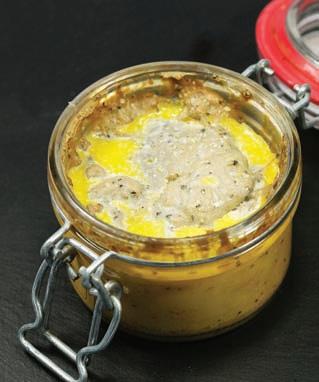
“Duck fat is liquid gold to the home cook”
Duck Confit Hash: Poached eggs, duck confit, thick cut Red Barn bacon, green onion and sriracha sauce on house hash browns at The Ruby.
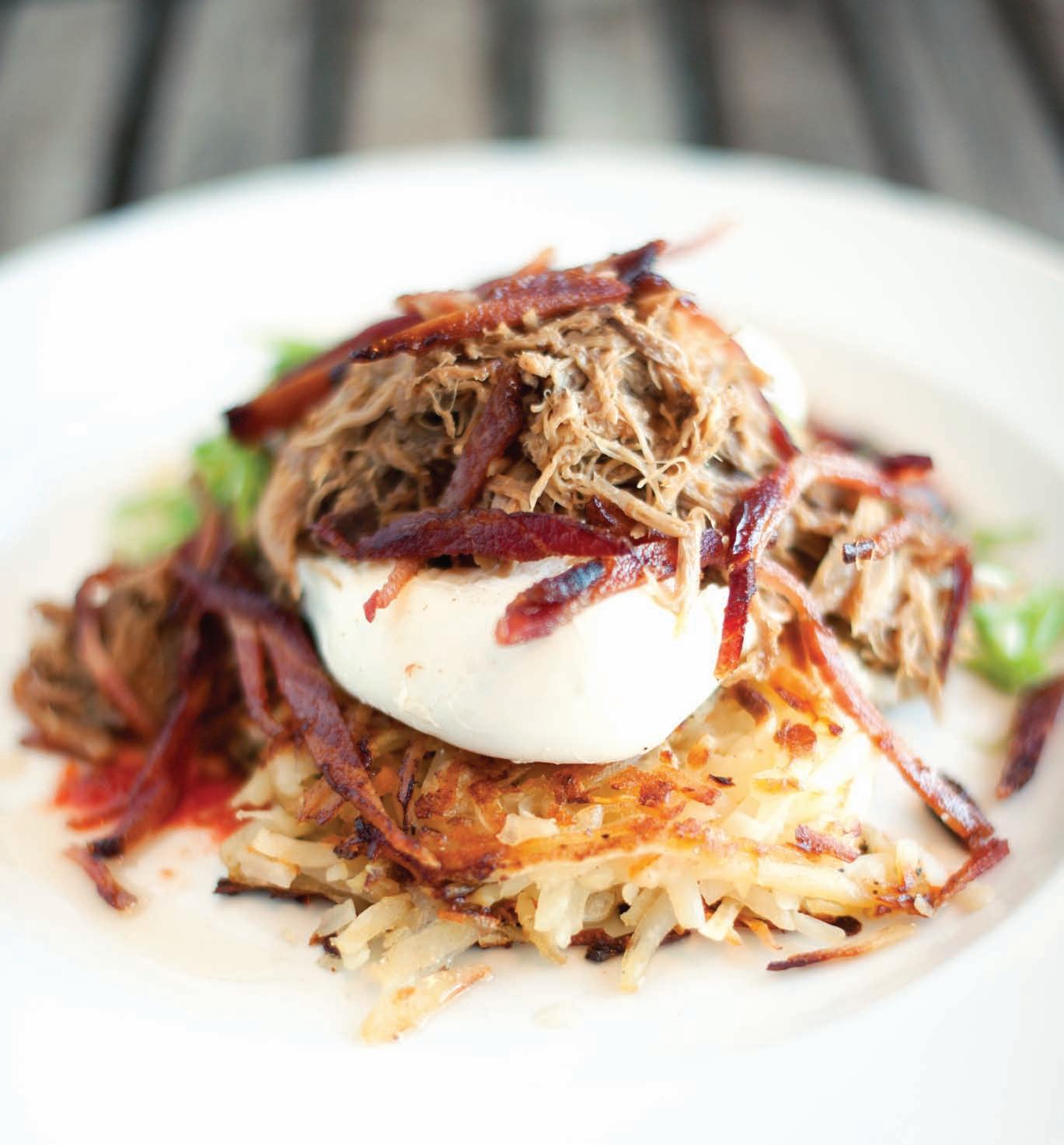



EAT Magazine is available thanks to the support of our advertisers. Please support them whenever you can

HUDSON’S ON FIRST

Award winning dining in a beautifully restored heritage home. Local ingredients, classic techniques and made from scratch cooking are a just few reasons to visit us in Duncan more often.

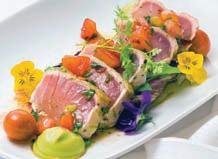


Celebrate Bubbles & Brunch, Lunch and Dinner.
163 First St. Duncan, BC 250-597-0066
www.hudsonsonfirst.ca


THE COMMUNITY FARM STORE
The Community Farm Store, organic health and whole food market in Duncan. Open 7 days per week. 10,0000 square feet of planet friendly market style shopping ... with heart. No GMO's! Good for you, good for the planet. 5380 Trans Canada Hwy, Duncan, BC 250-748-6227
www.communityfarmstore.ca
DUNCAN GARAGE CAFE & BAKERY

A community favourite! The best food, coffee, smoothies and baking in town. Buzzing with interesting people, vibrant staff and a funky vibe. Always healthy, fresh, creative and home-made. Great food using great ingredients!!
5380 Trans Canada Hwy, Duncan, BC 250-748-6227

www.communityfarmstore.ca
The Happy Goat Cheese Company is located in the idyllic Glenora Valley, just south of Duncan. Using traditional methods, we make aged, raw milk cheeses using fresh milk from our own herd of happy goats. 5060 McLay Road, Duncan, BC 250 701 7533 info@thehappygoat.ca

Part kitchen, part market, Fig serves everything from shawarma to roast lamb. Cooking at home? Ou r extensive grocery selection will provide you with all the ingredients for your own recipes.
1551 Cedar Hill Road (south side between Cedar Hill Crossroad and Shelbourne), Victoria, BC 250-727-3632 info@figdeli.ca


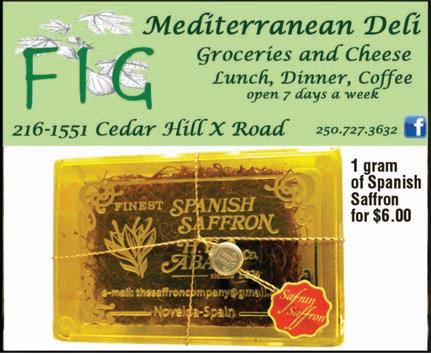
A funky little café with an incredible view, great coffee and lots of home baking - for breakfast, lunch and dessert. Jazz Café on Fridays will continue in October. Winter hours (closed Wed) Weekdays 9-5pm, Weekends 10-5pm.
325 Fernw ood Road
(just across from Fernwood dock, north end) Salt Spring Island
250-931-2233, www.fernwoodcafe.com
Voted the World’s Best Romantic Hotel in 2014, "Hastings House offers both Fine and Casual dining in either the main dining room or in our newly designed Bistro. Both menus are inspired by award winning chef Marcel Kauer using the freshest of local ingredients" www.hastingsho use.com, 1-800-661-9255
160 Upper Ganges Road, Salt Spring Island
New Fall Collections arriving from Europe, California and Canada. Sweaters in greens, greys, browns and black. Comfortable, modern pieces with stylish details in natural fabrics. Contemporary art by Local artists Michela Sorrentino and Pat Murphy MacDonald.
102 - 150 Fulford Ganges Road www.facebook.com/PodContemporaryGallery www.podcontemporary.com

Our menu offers daily changing specials for your dining pleasure! From late September and throughout October, visit us for our unique Oktoberfest-themed selectionsavailable in our Restaurant and Deli.
We are open daily for Breakfast, Lunch and Afternoon High Tea. 5325 Cordova Bay Road, Victoria, BC 250-658-1535

www.AdriennesTeaGarden.com



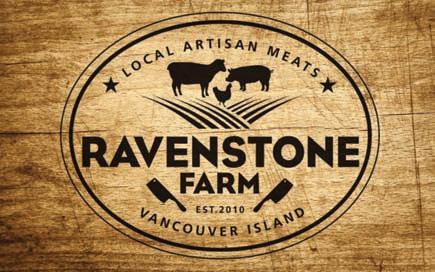
We produce a wide variety of hand crafted meat products made in small batches from locally sourced ingredients. Stop in at our Victoria Public Market shop to browse our selection of fresh sausages, pasture raised meats and smoked deli cuts or enjoy one of our delicious deli sandwiches.
1701 Douglas Street. (The Victoria Public Market) (778) 432 2899
Open 7 days a week
Victoria in the Fall. Local meat and vegetables simmering in a big Le Creuset pot. Leaves turning colour, time to cook. Come and see us for Le Creuset, Fiestaware and much more.
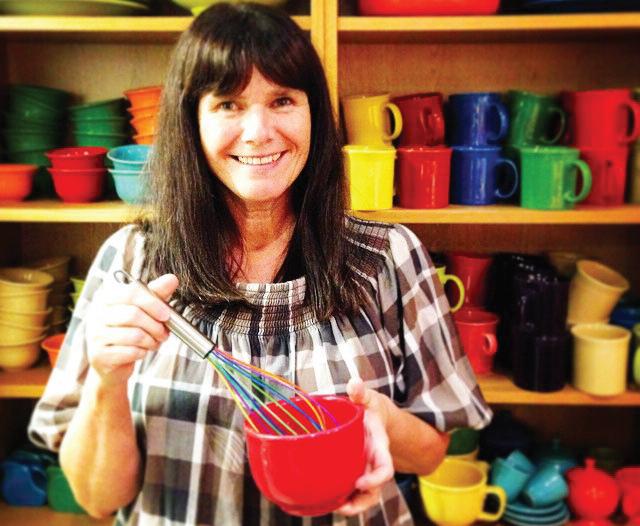
At the Victoria Public Market, 778 - 433 - 9184 Whiskvictoria.ca. Facebook and Instagram
Open 7 days a week

The Roost passionately grows its own food and wine on 10 acres for a true Saanich Peninsula farm to table experience. A food destination like no other.
9100 East Saanich Road, North Saanich, BC 250.655.0075
www.RoostFarmCentre.com


Poor zinfandel. Though California’s flagship grape certainly has experienced the highest highs, the ingrained legacy of White Zinfandel has tarnished this bold, layered, spiced red. Hailing from Croatia (where it is known as tribidrag), and also prolific in southern Italy (known as primitivo), this productive red is well used / abused for high yields of sunbaked jammy, ripe fruit. However, when care is taken and cropping is low, high quality, long-lived and complex wines result. Some of California’s top wines come from old, dry farmed, gnarly zin vines, brought by Italian immigrants in the mid-19th century. Typical characteristics of zinfandel include moderate tannin, higher acidity and alcohol, and ripe flavours of boysenberry, raspberry, plum, tobacco and baking spices.
Ridge 2011 Lytton Springs Zinfandel Sonoma County, California
$55 +178236
Old vine heritage zinfandel (82%) is splashed with petite sirah and carignane, opening with dusty black cherry, anise, olive and dark floral notes. Acidity is brisk and structured tannins are firm. Lovely bones, clad in expressive, fragrantly herbed black fruit. Can easily hold another decade. 92 points.
Pentâge Winery 2013 Rosé Skaha Bench, Okanagan Valley, BC
*$20
This deeper pink hued wine opens with cocoa, red currant and dark cherry jam. The off-dry palate is juicy with blackberry, ripe cherry, dark florals and zesty spices, with a mouth filling cherry cordial note. 87 points.
Farnese 2012 Fantini Primitivo Puglia, Italy
$11.49 +619163
Dark flowers, plum and perfumed blueberries open this smooth, fresh red. Black and red raspberries, blackcurrants, red liquorice and dried rosemary charm on this medium bodied, honest, mid-week sipper. 86 points
Rodney Strong 2012 Zinfandel Knotty Vines
Northern Sonoma, California
$21.49 +264739
Baking spice, blackberry and black liquorice lead to a ripe palate. Vanilla, sweet cinnamon and cloves frame dense, sweet black and blue fruit jam and round tannins, with Dr. Pepper note on the finish. 86 points.
Verosso 2013 Primitivo Salento Puglia, Italy
*$17 +468660
Robust and earthy, reflecting the hearty southern Italian terroir. Full bodied and ripe, with dense plum, blackberry, leather, sticky tannins and a gutsy, warming finish. 87 points.
Covert Farms 2012 Zinfandel Grand Reserve
Okanagan Valley, BC
*44 +517243
Medicinal dark cherry, black plum and lacquer open this bi g, jammy red and continue to the ripe palate, where it is layered with leather, dried cherry, prune and herbed blackberry compote. Dense fruit and ragged tannins call for roast lamb. 87 points.
*Asterisks denote wines that are only available at the winery or select private liquor stores.


On October 3rd a dream-team of talent descends on the sleepy hamlet of Mill Bay to stage a spectacular show on a floating barge. However, if you think fireworks are the main event of this show, you’d be quite mistaken. The show, called “Sip, Savour & Support” is a culinary one, specifically a gala “long table” dinner event that serves as the wind up to the “Savour Cowichan Festival”, an annual 10-day affair that celebrates the Cowichan Valley’s vast cornucopia of locally grown and produced food and drink.
So, who will be cooking? Kyle Bellis (Merridale Estate Cidery), Tom Corless (Bridgemans Bistro), George Gates (Best Western), Matt Horn (Cowichan Pasta), Dan Hudson (Hudson’s on First), James McClellan (Shawnigan Lake School), James Walt (Araxi Restaurant + Oyster Bar), Brock Windsor (Sooke Harbour House).
For more information about Savour Cowichan Festival and “Sip, Savour & Support”, visit savourcowichan.com Tickets are $200 each.



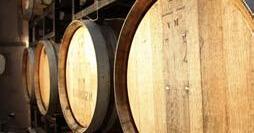


Company Lager - Lighthouse Brewing Co. (Victoria BC)

This is an anywhere, anytime beer. It fits into that intermediary fall time so well because lagers are really easy to pair; they go with just about everything. It can be refreshing if it’s still hot out, or it can be warming if it has chilled down outside. The Company Lager from Lighthouse is a good, clean, crisp version of a lager that has a subtle honey taste.
ABV: 5.5% (lighthousebrewing.com)

Paprika-rubbed pork tenderloin, chimichurri, and thyme charred carrots and potatoes.
Fall’s weird. You can have a BBQ one night, and then stew another because of the crazy change in the weather patterns. This meal’s pretty onpoint if you need something tha t can go either way. Nice out? Grill the pork, and roast the potatoes and carrots on the barbecue with the pork. Not-so-nice out? Grab your cast iron pan (you’ve got one right? If no: get one ASAP) and cook all that stuff together in a big 12-inch. Make sure to rub paprika, salt, pepper, and garlic all over the tenderloin and let it sit for a bit, then cook it up. Par-boil the veg to speed up the process if you’re strapped for time. The colouring on this meat is insane, and the ease of cooking means you can’t mess it up, and even if you do it will still be delicious. Serve with chimichurri sauce.
The two of these go together so well it should be illegal. Have a bite of the pork, enjoying the paprika and chimichurri, then sip your lager and go back to the pork. It will be as if the paprika is a whole different spice; you won’t know what hit you. E



 g TERROIR By Michaela Morris
g TERROIR By Michaela Morris
ABUTTING THE ATLANTIC OCEAN IN EUROPE’S FAR WEST, Portugal is somewhat off the beaten track. Occasionally it’s even disrespectfully lumped together with Spain. Yet Portugal has its own unique history and identity, which is also very evident in its wine. Port, Mateus rosé and Vinho Verde represent Portugal’s most famous exports, and while they have their place, plenty of brilliant offerings beyond these are begging to be discovered.
This small country packs in an incredible range of great wine. Climatic differences (from the cooling Atlantic Ocean to drier and hotter pockets further inland and south) along with diverse soil provide a unique playground for a huge assortment of intriguing indigenous grapes. I was once asked if I thought the sheer number of native grapes (approximately 250) was an advantage or an obstacle. I responded immediately and enthusiastically: “An advantage!” This array of varieties gives Portugal the ability to produce wines not replicable anywhere else.
Yet I also recognize the challenge it presents. Wine drinkers in “new world” countries like Canada tend to select wines by grape variety. As the majority of Portugal’s grapes are grown exclusively there, they are unknown to most wine drinkers. Their names are often hard to pronounce and may change from one region to the next.
Further complicating the issue, the practice in Portugal is to blend. In fact, traditionally wines were “field blends,” meaning different grapes were grown together randomly in the same vineyard, harvested at the same time and vinified together. While other countries have a history of field blends, Portugal’s practice persisted well into the 1970s. Today, grapes grow in separate plots, with blending occurring after vinification and élevage, but in older vineyards you can still find dozens of different varieties growing together side by side.








Serious studies of Portugal’s individual grapes began in earnest only within the last couple of decades. This research has helped identify Portugal’s greatest treasures. The highly touted red grape Touriga Nacional has even been proposed as Portugal’s flagship variety. Deeply coloured and firmly structured but packed with fruit and flavours, it is certainly one of the country’s finest.
The burning question, though, is in a country where blends rule, is a flagship grape necessary? Undoubted ly, there are plenty of delicious examples of single varietal Touriga Nacional. Yet at a master class on Portuguese reds, renowned academic and wine writer Luís Antunes explained, “Touriga Nacional can be excessive, that is why it needs to be blended.” Tinta Roriz, the same grape as Spain’s Tempranillo (and known in some Portuguese regions as Aragonez), is a common blending partner imparting finesse as well as a layer of red berries. Touriga Franca also helps out with its enticingly floral notes and smooth round tannin. And this is just a start to Touriga Nacional’s cohorts.
During my visit to Portugal last May I had the privilege of judging at their national wine competition. (Imagine 1,200 wines in three days!) This year saw the introduction of a new category: “Best single varietal.” Was this an indication that Portugal might be moving in that direction? Jorge Monteiro, ViniPortugal CEO, assures me not. “One of our strengths comes from the blended wines, but for consumers to understand what is a Touriga Nacional/Trincadeira blend, they need to ‘feel’ the taste and aromas of each individual grape variety.” Trincadeira by the way gives notes of spice and fragrant herbs as well as useful acidity.
In the region of the Dão, Luís Lourenço, owner of Quinta dos Roques, puts this philosophy into action.“The traditional wines of Dão were always blends, but I came from a math background where 2 + 2 = 4. It’s not the same in winemaking.” In order to understand what he has to work with, he crafts wines from single varieties. It is a treat to taste these different grapes on their own. However, the reds offering the most complexity and intrigue are his blends, where the sum is great than the parts.

Portugal’s 250 native grapes make for a cornucopia of unique blended wines.
And while valuable research into Portugal’s endless parade of native grapes continues, many producers are also harking back to olden times. At the historic property of Casa da Passarella in the Dão, the dynamic team is replicating vine by vine an exact copy of its eighty-year-old vineyard inter-planted with more than 24 different varieties. That is one tasty field blend! Truly, without the efforts of producers such as this, some very precious traditions would fade away.
Keeping traditions alive would not make any sense if the wines didn’t deliver in the glass. Portugal succeeds admirably on that front. While it’s impossible to generalize, I would say that overall the reds are friendly but refreshing, allying structure with ripe fruit. These hunger-inducing wines complement the robust and flavourful fare of Portugal but are easily transferable to our own cuisine here in B.C.
If this isn’t enough to entice you, then perhaps the incredible value for money is. This doesn’t simply mean cheap wine. Yes, Portugal produces a whack of really good wines for well under $20. However, it also offers many premium wines that seriously over-deliver for the price. For a fairly modest investment of under $50, it is easy to find plenty of cellar-worthy wines. This is a mere fraction of what many Bordeaux sell for these days, by the way.
When it comes to Portuguese wine, all that is required is a sense of adventure. Start with the warming reds below as the days cool down. Once you’ve familiarized yourself with these, know that a whole world of Portuguese sparkling, white and sweet wine awaits you as well.
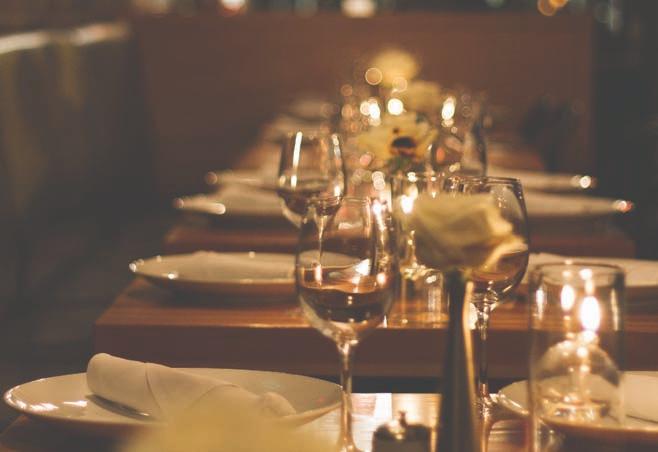
2013 Quinta do Crasto, Douro DOC $17-19
Though the Douro Valley is best known for the production of port, it has a solid reputation for fullbodied dry reds made from the same roster of grapes. Touriga Nacional shares the spotlight with Tinta Roriz, Tinta Barroca and Touriga Franca. Exuberant and fruit-driven, but assertive tannin and acidity keep it all in check.
2012 Meandro do Vale Meao, Douro DOC $28-32
A similar blend to the above, the Meandro offers additional complexity and elegance for the price. Blackberry, black cherry, licorice, violet and coffee mingle. Concentrated yet refreshing, it would pair beautifully with lamb. You could hold onto it for three to five years.
2008 Quinta do Convento, Duoro DOC $32-36*
A great example of a wine with some age though it still has life ahead of it. Savoury leather and iron notes along with baked raspberry, wild flowers and dark chocolate are held together by dry firm tannin. Would work with any hearty mushroom dish.
2013 Casal de Tonda ‘Grilos’ Dão DOC Tondela $13-15
Touriga Nacional partners with Alfrocheiro and Tinta Roriz. Full-bodied and earthy without sacrificing fruit, it offers black plum and violets with a lingering licorice finish. So suitable for sausages.
2010 Pedro Cancela, ‘Seleção do Enólogo, Dão DOC $18-20
The same mix of grapes shows up here. An enticing gaminess is offset by wild strawberry, fragrant mint and cinnamon. The minerality on the palate makes my mouth water for duck rice.
2011 Quinta do Encontro, Bairrada DOC $18-20*
The region of Bairrada is unique in that the wines traditionally were made solely with the excruciatingly tannic Baga grape. Recent changes to the DOC allow the addition of international grapes. Here 50 percent Merlot works to soften tougher Baga. Plush plum with leather and tobacco, it’s smooth but finishes with a firm hand. Suckling pig is a must.
2012 Casa Ermelinda Freitas, Monte da Baia, Península de Setúbal $11-12
Castelao (Portugal’s most planted red) and Touriga Nacional embrace non-native Syrah and Cab Sauv. Fresh, characterful and lush with a mouth-filling burst of cinnamon, currants and vanilla. Why not try with a Moroccan chicken stew?
2012 JP Azeitao, VR Península de Setúbal $12-13*
(50% Castelao, 35% Aragonez, 15% Syrah) Simple but charmingly exuberant with succulent raspberry. Very approachable and soft. I would chill it slightly and drink with burgers on a warmer autumn eve.
Prices exclusive of taxes.
*Asterisks denote wines that are only available at the winery or select private liquor stores.
250-388-4949
104-1175 Cook Street cookscafe.ca
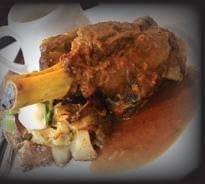
ictoria'sV
Victoria's Newest Foodie Hot Spot, offering breakfast all day until 4pm and West Coast inspired International Fusion.

Happy hour 3pm-6pm Wednesday - Saturday featuring $3.00 Bottles of Phillips and Coronas
Monday and Tuesday 7:30 am to 3:00 pm
175104-1 est and W ednesday of W ednesdayW uesdayT

Wednesday - Friday 7:30 am - 9:00 pm Saturday 9:00 am - 9:00 pm Sunday 9:00 am - 3:00 pm


Tomas Dosil (TD)
Co-owner, Chorizo & Co. (Victoria)
Originally from Valencia, Tomas Dosil’s family moved to Victoria when he was a child and the flavours, scents and traditions of his homeland were continued in Victoria. After a sixteen year career in the hotel industry, he realized his dream of opening a Spanish tapas bar, deli and shop in 2012.
Tatsuya Katagiri (TK)

Executive Chef / Wine Director - Zest (Vancouver)




















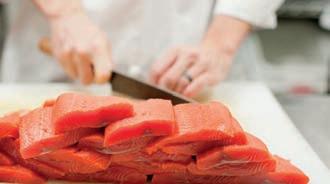
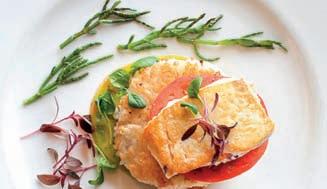


Chef Tatsuya is the new wave in Japanese cuisine, merging traditional cooking techniques and form for contemporary tastes. After working at a traditional Japanese restaurant in Tokyo, Tatsuya made his way to the kitchens of Calgary, where he also began his wine studies, completing ISG and WSET Advanced. At Vancouver’s Zest, he prefers to pair BC wines to his playful Japanese cuisine, matching local wines with local ingredients.
Wine Pairings: Tea-smoked Scallops with Honey-Orange Marmalade (ginger, garlic, star anise, black tea, soya)

TD. With the scallops I would look for a fuller bodied, off dry white. A moscatel blend from Catalunya should enhance the sweetness of the honey orange marmalade nicely. That said, my heart says to try a fruity, slightly acidic godello from my home region of Galicia, Spain.
TK. By smoking scallops, it gets more sweetness, minerality and umami. I would look for something with mineral, citrus, honey, spice to match the main flavours of orange, star anise, honey and ginger. My first suggestion is Alsatian gewürztraminer. Minerality works for scallops and the aroma of lychee and orange blossoms goes well with sauce, while ginger and star anise pair with the sweet and spicy finish of wine. My second pick would be a BC pinot blanc, fruit forward and mineral, with a warm citrus flavor and crisp finish – will go well with sweet honey orange marmalade.
(prune plums, chicken stock, shallots, merlot)
TD. For the duck I would look for a young and lively tempranillo from Rioja to balance the natural fattiness of the duck.
TK. Merlot. Using fresh plum gets more lively fruit flavor, and butter makes the sauce weightier. I am heading to the new world and pick Argentina malbec - soft, juicy, fruit forward and with elegant tannins.

Honey: Everyday Recipes for Cooking and Baking with Nature's Sweetest Secret Ingredient by Angelo Prosperi-Porta can be purchased at your favourite book store. Published by Touchwood Editions. $26.95
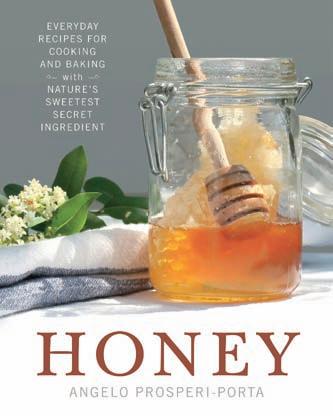
For this edition we are pairing to two recipes from the newly published Honey by Sooke, BC cookbook author Angelo Prosperi-Porta.
WHITE WINES:
By Larry ArnoldJoie Riesling 2013 Okanagan Valley $23.00-26.00
Pleasure in a glass! Pure clean fruit with a subtle hint of mint on the nose, mediumbodied with juicy citrus, apricot and tropical fruit flavours restrained by a slash of crisp, bright acidity. Terrific balance with plenty of character and a long zesty finish.
Domaine Bernard Defaix Chablis 2014 France $25.50-28.50
Very stylish with plenty of fruit and loads of personality. It is everything you could possibly want of a bottle of Village Chablis. Ripe but focused with delicious peach and citrus flavours, a salty minerality and no lack of concentration or class. Very good indeed.
Finca Los Primos Torrontes 2014 Argentina $12.00-14.00
Here’s a simple, lovely white from the foothills of the Andes. You don’t need to stick your nose in a glass looking for fleeting scents of fruit. Torrontes lays it all out for all to behold. Candied lemon, ginger, nectarine, rose petals, freesias, my great aunt Eileen, a primordial potpourri of the familiar and exotic in each and every sip. So generous, so rich, so hedonistic and then boom the finish. Firm, maybe even on the dry side of fruit and gone with a sigh.
Mezzacorona Pinot Grigio 2014 Italy $12.00-15.00
I have written about this simple little charmer from the foothills of the Dolomites many times, but it still needs to be said. In a world awash with cheap Pinot Grigio, Mezzacorona stands out not only for its consistent quality but also for its reasonable price. Green apples, peach, mineral, perhaps a note of salinity, it’s all there. A very generous quaffer with juicy fruit flavours and refreshing acidity.
RED WINES:
Can Blau Monstant Red 2012 Spain $25.00-28.00
Monstant is a mountainous region just to the south of Barcelona. It is very black with a nose redolent of boysenberries, wood smoke and an underlying earthy fecundity that the more delicate amongst us may find unsettling. The nose and the colour alone are worth the price of admission. Full-bodied and meaty with layers of dense black fruit flavours that play with your palate enveloping it with a chocolaty coat tannin. For your inner Bohemian.
Boekenhoutskloof Porcupine Ridge Syrah 2013 South Africa $14.75-17.00
If you are looking for a good Syrah at a good price look no further, this tasty South African Syrah from dry-farmed vineyards in the Swartland region, is your wine. Fullbodied and lightly oaked, with fresh blackberry, cedar and spice flavours, nicely balanced with dusty tannins and soft acidity.
Penfolds Bin 138 Old Vines GSM 2012 Australia $32.00-35.00
After twenty years they still have the magic, Penfolds has released another classic Barossa Valley blend. A blend of Shiraz (66%), Grenache (23%) and Mourvedre (11%) sourced from old vines in the Barossa Valley and aged for 12 months in seasoned American hogsheads. Bin 138 is one of the best values in the market. Fat and rich with kirsch, boysenberry and spice flavours nicely balanced with rounded tannins and lively acidity.
Belle Glos Dairyman Pinot Noir 2013 California $43.00-45.00
This release of Dairyman Vineyards, in the Russian River Valley, will not disappoint. Concentrated and powerful with heady aromas of red cherry, spice and earth fill the glass and develop slowly across the palate. Full-bodied and richly textured with sweet fruit flavours, soft acidity and silky smooth tannins. A big juicy pinot worth every penny.

Venturi Schulze Brandenburg No.3 2010 Cobble Hill $36.00-40.00 (375ml)
A question? What dessert wine would you pair with Crepe Suzette, heavy on the Grand Marnier? Well, since you asked, I would, without a second thought reach for a bottle, actually a half bottle, of Venturi Schulze’s unique masterpiece, Brandenburg No.3. Unique because of all the gin joints on this planet there really is nothing like it. Made from estate grown Madeleine Sylvaner simmered for what seems an eternity, the result is the transfiguration of the simplest of wine into the otherworldly Brandenburg No.3. Concentrated rather than rich it tastes and feels sort of like a Pedro Ximenez, Palo Cortado, Bual, Banyuls, Colheita Tawny cross. Smoke, dried fruit, walnuts, and spice, sweet and savory at the same time, in essence a superb vinous conundrum! E
VICTORIA: I’ve said it before and I’ll say it again – autumn is my favourite season. The days are still long and warm, the market stands are overflowing with all the beautiful nightshades – tomatoes, peppers, eggplants, potatoes – as well as all things squash. Also, the tourists have mostly all gone home, which is a shame for them, because there is a great crop of festivals around Victoria at this time of year, especially those catering to the thirsty. First up is the Great Canadian Beer Festival, held at the Royal Athletic Park Sept 11-12. At last count, this benefit for C-Fax’s Santa Anonymous was expecting 62 different craft brewers from BC, Quebec and Ontario. Food vendors include Pig, The Hungry Rooster and Taco Justice, so you won’t be going hungry either. (gbcf.com) Next on the list is the Victoria Wine Festival – a fundraiser for the BC Hospitality Foundation, running Sept 25-26 at the Parkside Hotel and Spa. (vicwf.com) Rounding out the trifecta is the Art of the Cocktail festival, featuring tastings, seminars and competitions Oct 24-25. (artofthecocktail.ca) If you are a scotch drinker and you’re feeling a little left out, have no fear, there’s something for you too! The Harbour House Restaurant is hosting a Single Malt Scotch Whisky tasting, guided by Scotch Whisky Ambassador Brian McQueenie on Sept 9. (tartanup.org)
There is no shortage of great ways to enjoy food and drink outdoors at this time of year – the annual Vancouver Island Feast of Fields is being hosted by Shawnigan Lake’s E.C.O Village on Sept. 20. (farmfoldcityfolk.ca). Sea Cider Farm and Ciderhouse is hosting a long table Harvest Dinner featuring locally grown food prepared by Food for Thought Catering and paired with their own award-winning ciders on Sept 24. (seacider.ca) If you are happy to do some island hopping, the Salt Spring Island Apple Festival will take place on Oct. 4 (saltspringmarket.com) and the Galiano Island Blackberry Festival is happening over Thanksgiving weekend, Oct 10-12. (galianofoodprogram.ca) W hile on Galiano, you’ll want to check out pilgrimme, the farm to table restaurant that was just nominated as one of Canada’s best new restaurants by enRoute magazine, along with Sooke’s Wild Mountain – congratulations to both! (facebook.com/villagetacosgaliano) (wildmountaindinners.com)
This summer was a time of rebranding, renovating and/or relocating for several local food businesses. Chez Michel, on Oak Bay Ave, completed its renovation and rebranding and is now Confit Food + Wine Chef Dwane MacIsaac has taken over the kitchen and the restaurant is open for lunch Wed-Fri and dinner Tues-Sat. (confitfoodandwine.com). The Best Western Hotel on Johnson St. has said goodbye to The Stone’s Throw and hello to the London Tube Restaurant. The popular Greek restaurant Eugene’s said goodbye to their location at the corner of Fort and Foul Bay and, at press time, was preparing to open a new establishment, The Village Taverna, at the corner of Cook St. and Pendergast. Friends of Bears (1310 Douglas St.) changed their name, décor and menu and reopened as the Mexi-Cali Café and Salsa Co.
At 1724 Douglas St, Northern Quarter is a new community-inspired restaurant venue brought to you by Benji Duke of the Fort St. Café and Torin Egan of the Superior Café. Self-described as a “modern interpretation of a public house, Northern Quarter will offer local, seasonal cuisine, selected bar menu and
inspired live performance. You can expect refreshing happy hours, a relaxed dining experience and well presented late night entertainment.” (northernquarter.ca). A sign in the window at 1813 Douglas St. tells us a new resta urant offering modern Thai cuisine, @Bangkok, will be opening soon. And in food truck news, the newest truck in town, Ginger Bros. Burritos, is serving up breakfast burritos and more from their regular location near the Farmer Construction office on Harbour Road. (gingerbrosburritos.com).
Beaver Tails, the iconic Canadian cinnamon-sugar topped pastry, can now be found in downtown Victoria at 602 Brou ghton. If you haven't got a sweet tooth, they also have poutine on the menu. (beavertailsinc.com)
This just in: Niagara Grocery has started crowd funding campaign to raise the down payment to buy the building they’ve been renting since 2009 and ensure they are part of the community for many years to come. To contribute, visit indiegogo.com/projects/save-space-for-niagara-grocery. The contribution drive closes on September 14th. —REBECCA
BAUGNIET
: With many Harvest festivals to celebrate in September and October, it's hard not to think about Mother Nature and where we stand this fall with all of our dry, hot weather; did every crop make it through, are they smaller yet packed with extra flavour, did some things thrive where others failed? Answer some of these questions for yourself by attending an event or two!
In bountiful Cowichan Bay, Savour Cowichan is back for another year. Starting Sept 25th jump on the shuttle and get off whenever your heart desires to sample local wines, cheeses and spirits. Or 'Barge on In' on the waters of Mill Bay while partaking in gourmet goodies and popular libations. There are many wine events, cooking classes and winemakers dinners to choose from. savourcowichan.com
Shawnigan Lake hosts this years' Feast of Fields on Sept 20th. In this spectacular setting, experience gourmet creations from top BC chefs, farmers, fishermen, ranchers, food artisans, vintners, brewers and distillers. In its 18th year, this is a premier event not to be missed. feastoffeilds.com

At Lake Cowichan on Sept 26th is the Salmon & Mushroom Festival where you can experience a variety of gourmet wild mushrooms and salmon. Sign up for a mushroom foraging class, or watch an identification presentation so you can learn to hunt for your own table safely. salmonmushroomfestival.com
One of my favorite events of the year is Salt Spring Island's Sip & Savour. This time they are trying out a new weekend for the event starting on Oct 9th with a choice of winemaker dinners at participating restaurants such as Stowel Lake Farm, Hastings House and Auntie Pestos. On Saturday visit the worldrenown Salt Spring Island Saturday Market before taking in the Grazing Event in the afternoon, and don't miss Bubbles and Brunch on Sunday or the Harvest Long Table Dinner. With so many award-winning places to stay, eat and drink it's impossible not to have a fantastic time! sipandsavou rsaltpspring.com
Continuing on the festival tour, Nanaimo Bites & Sights kicks off on Sept. 4th with a three-hour, guided culinary walking tour of historic Nanaimo & Old City Quarter, combining tasty food, historical commentary and culinary insights all provided by a local guide. nanaimobitesandsights.com
Unrelated to festivals but of interest to all birds of a feather; Nest Bistro recently relocated fr om their old location to 77 Skinner Street in Nanaimo. 'Nest' assured, you won't be disappointed with their continued dedication to dining excellence! There's a new place in Nanaimo called the Milton Street Public House - previously Fox & Hound - new owners Rob and Sandy Wilkinson owned Ladysmith's Page Point Bistro the previous 5 years, and hope to bring new flavour to the Old Quarter. Find them on F B. thenestbistro.com
Denman Island plays host to two festivals this fall: the 1st annual Apple Festival on Oct 10th and the Mushroom Festival on Oct 24th. Two great opportunities to get away from it all and take in local bounty at the same time. Find them on FB and hello bc.com
New to Parksville is the Radius Food Co., working hard to connect farmers to customers by providing you with a unique gastronomic experience using food grown and obtained in a way that respects the well being of farmers and the environment. radiusfoodco.com






Qualicum Beach and Butlers in the Crown Mansion Boutique Hotel is now run by former owners of Toscano's Restaurant in Comox. They have created a new mouthwatering Italian inspired menu to compliment the timeless elegance of the hotel. crownmansion.com
In Courtenay located beside new Gladstone Brewing Co., Guerrilla Foods opened the brick fired Guerrilla Food Company enabling you to take home an authentic pizza pie with that newly filled growler, or simply stop in and enjoy a flight and a pie in-house. Finally in Comox, the Avenue - previously owned by the Atlas - has new owners who continue their dedication to providing locally sourced ingredients straight from the valley. tgfc.ca, avenuebistro.ca
No matter what Mother Nature revealed to us this fall, I think she's saved at least one mystery for spring; will a bumper crop of morels and other mushrooms poke through the ash left by the wildfires?
Wait and see...
TOFINO | UCLUELET: Ucluelet is a short half hour drive from Tofino, but it seems I don’t get down there frequently enough. On a recent trip, I realized I’ve been missing out on several new culinary options.
One new addition is Raven Lady, an upscale food truck at 1801 Bay St. (at Peninsula Rd.). This is where Jiggers Fish and Chips was located (they have moved just down the street a little ways to 1685 Peninsula Rd). Named for the sculpture which graces the street corner (and has been spruced up), Raven Lady is designed for oyster lovers. You can have them naked on the half shell, panko crusted, smoked with blue cheese, and in a linguine, curry and Caesar salad. I had the Po’ Boy with panko oysters, chimichurri, pickled watermelon and coleslaw on a crispy baguette. It was good enough that I wished I could sample more from the menu, but filling enough that it will have to wait for the next Ukee trip. ravenlady.ca
Wes t coast locals have been excited for some time about the re-opening of the former Smiley’s restaurants and bowling alley. Under new ownership and completely refurbished, Howler’s Family Restaurant and Amusements now boasts a bowling alley, billiards and an arcade, along with a restaurant serving breakfast, lunch and dinner, and grocery selections. Howler’s is also fully licensed, and by the looks of it some entertaining staff parties have taken place there already, along with loads of family fun.
Abbondanza Pizza is another new addition to the Ucluelet food scene, recently opened by Corey Crabbe (formerly of Surfside Pizza). Wood fired pizza is the house specialty, and you’ll find this new spot in the former Number One Market space at 1972 Peninsula Rd. (Unit A).
I’ve already extolled the virtues of Zoe’s Bakery and Café on these pages, but it does deserve another quick mention. This former pastry chef who has worked at Fetch at Blackrock Oceanfront Resort and the Pointe Restaurant at the Wickaninnish Inn delights her loyal customers with daily fresh baked sweet and savoury treats, and truly excels at wedding cakes. I’ve also mentioned Ukee Juice before here, and owner Ashleigh Drummond, who is a certified nutritionist specializing in raw, vegan and gluten free fare with local and organic ingredients. ukeejuice.com
And of course there’s Hank’s Untraditional Barbecue, Fetch at Blackrock Oceanfront Resort, and Norwood’s to name a few of my other favourite standbys. When combined with the Wild Pacific Trail and Ucluelet Aquarium, an Ukee excursion is a complete day’s affair.

In recent Tofino news, the Wickaninnish Inn was recently named the top resort in Canada by Travel + Leisure magazine’s World’s Best Awards for 2015. These awards, voted on by the magazine’s readers each year, also saw the Inn being voted the number 12 resort in the world. wickinn.com
Like many areas on Vancouver Island this summer, Tofino was facing water restrictions. This can be an especially difficult challenge for restaurants and resorts, especially in the midst of the busiest visitation period. Many local restaurants took up the challenge admirably by serving water only on request, and tailoring other kitchen practices toward water conservation. Of special note, chef Ian Riddick of the Great Room at Long Beach Lodge Resort shared his many initiatives over social media as part of the #TofinoH2O initiative. For instance, Chef Riddick saved the boiled water from the crab pot to blanch clams (a water savings of 20 litres per use). Also, all washing sinks have been fitted with on-demand systems that only run when sensors are activated. To see more about Long Beach Lodge and chef Riddick’s water conservation efforts, please visit longbeachlodgeresort.com. Other efforts and tips can be found by searching #TofinoH2O on Facebook and Twitter. JEN DART








